Overview
- Brief Narrative
- Nazi propaganda poster featuring black and white photographs of happy German children next to text explaining Churchill's devilish plan to enslave German children if the Allies win the war. It describes a plan allegedly broadcast by Reuters news service that children, age 2-6, would be taken from their homes and forced to live abroad for 25 years so that German nationalism would not regenerate and the German race would cease to exist because it would be mixed with other races. The poster was issued on October 7, 1942, for the Parole der Woche (Slogan of the Week) series produced by the Nazi Party in Germany from 1936-1943. It was discontinued in 1943 because of paper shortages caused by the prolonged war.
- Artwork Title
- Deutsche Kinder als Sklaven und Geiseln!
- Alternate Title
- German Children as Slaves and Hostages!
- Series Title
- Parole der Woche Folge 41
- Date
-
publication/distribution:
1942 October 07
- Geography
-
publication:
Munich (Germany)
distribution: Germany
- Credit Line
- United States Holocaust Memorial Museum Collection
- Markings
- front,top, title, red ink : Deutsche Kinder als Sklaven und Geiseln! [German Children as Slaves and Hostages!]
front, subtitle, red ink : Teuflischer Plan Churchills ! [Churchill's Devilish Plan !]
front, center, 1st paragraph, first 2 lines bold, black ink : Die amtliche englische Nachrichtenagentur Reuter macht in einem Kabel-/ telegramm nach Südamerika folgenden ungeheuerlichen Vorschlag : / ,,Die deutschen Kinder sind nach dem Siege der Alliierten zu / internationalisieren. Alle deutschen Kinder im Alter von / 2-6 Jahren werden ihren Müttern weggenommen und für / die Dauer von 25 Jahren ins Ausland deportiert. Bei dieser / Methode werden die Deutschen dann nicht mehr von ihrer / Nationalität besessen sein. Dadurch wird ein Völkergemisch / entstehen, welches nicht mehr als deutsch zu bezeichnen ist!'' [The official English news agency Reuters sends a cable telegram to South America with the following outrageous proposal: The German children must be internationalized after the Allied victory. All German children aged 2-6 years will be taken away from their mothers and deported for a period of 25 years abroad. In this method, the Germans will no longer be possessed by their nationality. This will create a mixed race people, which can no longer be described as German!]
front, center, 2nd paragraph, bold black ink : Als Kinderräuber und Sklavenhalter über die deutsche Jugend / wollen also Churchill und Roosevelt im Bunde mit Stalin ihren / teuflischen Ausrottungskrieg gegen das deutsche Volk krönen. / Welches Schicksal unsere Kinder erwarten würde, wissen wir aus den Methoden der britischen Kolonialpolitik und des bolschewi- / stischen Terrors. Wenn die deutschen Kinder bei Verwirklichung / dieses Planes überhaupt ihr Leben behalten würden, müßten / sie erwachsen als internationale Sklaven für die plutokratisch-/ bolschewistischen Ausbeuterhyänen Frondienste leisten. [Like thieves and slaveholders of our German youth so will Churchill and Roosevelt in alliance with Stalin to crown their evil war of extermination against the German people. This fate would await our childrent, we know from British colonial policy and the Bolshevik terror. If the German children were to keep their lives in realization of this plan, they would have to grow up as slaves for the international plutocratic-Bolshevik exploiter hyenas of forced labor.]
front, picture caption, black ink : Sie solten das Opfer der Rache der vom Teufel besessenen Plutokraten sein [They would be the victims of the revenge of the possessed devil Plutocrats]
front; bottom, black ink underlined in red : Jetzt weißt du, deutsche Mutter / wofür deine Söhne kämpfen! / Es geht um unsere kinder - um unsere Zukunft ! [Now you know, German mother / What your sons are fighting for / It's about our children - our future!] - Contributor
-
Issuer:
Reichspropagandaleitung der N.S.D.A.P.
Publisher: Zentralverlag der NSDAP
Editor: W. Wächter
Physical Details
- Language
- German
- Classification
-
Posters
- Category
-
Nazi propaganda
- Object Type
-
Posters, German (lcsh)
- Genre/Form
- Posters.
- Physical Description
- Large offset lithographic poster with a graphic design in black, white, and red in landscape orientation. Across the top is the German title in stylized red font. The left side displays 4 black and white photographic images of blonde, cheerful children within a tall, narrow, white bordered rectangle tilted slightly left. The remainder of the poster has a large white rectangle with a top line title in red font, two long paragraphs in black ink, closing with 3 lines in bold, black font underlined in red. There is a narrow white border around the poster. There is a circular red Parole der Woche seal on the lower left. There are two labels adhered to the reverse: one has publishing information identifying it as a Parole Der Woche; the other is a book advertisement.
- Dimensions
- overall: Height: 33.125 inches (84.138 cm) | Width: 47.500 inches (120.65 cm)
- Materials
- overall : paper, ink
- Inscription
- front, lower right corner, handwritten, black ink : 7X.13X.1942 # 41
reverse, paper label, black ink : Ausgabe A / Die Parole Der Woche / Parteiamtliche Wandzeitung der NSDAP. / Folge 41 2. Ottober 1942. / Bezugspreis monatlich RM. - .80 / Erscheint wöchentlich einmal / [?]anbort München [Edition A / Slogan of the Week / Party broadsheet of the NSDAP / Subscription price per month RM. - .80 / Published once weekly / [?] Munich
revese, red label, black ink :
reverse, pencil : [?] 11/4l
Rights & Restrictions
- Conditions on Access
- No restrictions on access
- Conditions on Use
- No restrictions on use
Keywords & Subjects
Administrative Notes
- Legal Status
- Permanent Collection
- Provenance
- The poster was acquired by the United States Holocaust Memorial Museum in 1995.
- Funding Note
- The cataloging of this artifact has been supported by a grant from the Conference on Jewish Material Claims Against Germany.
- Record last modified:
- 2023-06-08 08:57:14
- This page:
- https://collections.ushmm.org/search/catalog/irn11237
Download & Licensing
In-Person Research
- By Appointment
- Request 21 Days in Advance of Visit
- Plan a Research Visit
- Request to See This Object
Contact Us
Also in Parole der Woche poster collection
The collection consists of broadsides and posters from the Parole der Woche [Slogan of the Week) series of propaganda posters issued by the Nazi Party in Germany from 1936-1943, and one postwar poster.
Date: 1936-1943

Nazi propaganda poster using British news reports to praise the power of the German Reich
Object
Nazi text only propaganda poster, Wie sag ich's meinem Kinde?, allegedly quoting a British newspaper editorial complaining that England has been sleeping while Germany has prepared for world domination, as shown by the German destruction of British naval convoys. Churchill is blamed and told to recognize how he has left his country unprepared, making parents and Churchill himself to wonder: How do I tell my child? The Nazi commentary congratulates Germany for being aggressive and prepared. The poster was issued on December 23, 1940, for the Parole der Woche (Slogan of the Week) series produced by the Nazi Party in Germany from 1936-1943. The series was discontinued in 1943 because of paper shortages caused by the prolonged war.
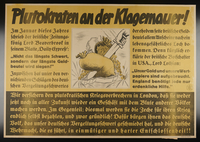
Nazi propaganda poster
Object
The Nazis used propaganda to buttress public support for the war effort, shape public opinion, and reinforce antisemitic ideas. As part of their propaganda campaign, the Nazis created the Word of the Week Series of posters (also referred to as Wandzeitung, or wall newspapers), the first of which was distributed on March 16, 1936. Each week, approximately 125,000 posters were strategically placed in public places and businesses such as: market squares, metro stations, bus stops, payroll offices, hospital waiting rooms, factory cafeterias, schools, hotels, restaurants, post offices, train stations, and street kiosks so that they would be viewed by as many people as possible. Posters were the primary medium for the series, but smaller pamphlets were also produced, which could be plastered on the back of correspondence. The posters used colorful, often derogatory caricatures, and photorealistic images with vibrant language to target the Nazis' early political adversaries, Jews, Communists, and Germany's enemies during the war. The series was discontinued in 1943.

Nazi propaganda poster
Object
The Nazis used propaganda to buttress public support for the war effort, shape public opinion, and reinforce antisemitic ideas. As part of their propaganda campaign, the Nazis created the Word of the Week Series of posters (also referred to as Wandzeitung, or wall newspapers), the first of which was distributed on March 16, 1936. Each week, approximately 125,000 posters were strategically placed in public places and businesses such as: market squares, metro stations, bus stops, payroll offices, hospital waiting rooms, factory cafeterias, schools, hotels, restaurants, post offices, train stations, and street kiosks so that they would be viewed by as many people as possible. Posters were the primary medium for the series, but smaller pamphlets were also produced, which could be plastered on the back of correspondence. The posters used colorful, often derogatory caricatures, and photorealistic images with vibrant language to target the Nazis' early political adversaries, Jews, Communists, and Germany's enemies during the war. The series was discontinued in 1943.
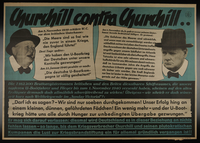
Nazi propaganda poster
Object
The Nazis used propaganda to buttress public support for the war effort, shape public opinion, and reinforce antisemitic ideas. As part of their propaganda campaign, the Nazis created the Word of the Week Series of posters (also referred to as Wandzeitung, or wall newspapers), the first of which was distributed on March 16, 1936. Each week, approximately 125,000 posters were strategically placed in public places and businesses such as: market squares, metro stations, bus stops, payroll offices, hospital waiting rooms, factory cafeterias, schools, hotels, restaurants, post offices, train stations, and street kiosks so that they would be viewed by as many people as possible. Posters were the primary medium for the series, but smaller pamphlets were also produced, which could be plastered on the back of correspondence. The posters used colorful, often derogatory caricatures, and photorealistic images with vibrant language to target the Nazis' early political adversaries, Jews, Communists, and Germany's enemies during the war. The series was discontinued in 1943.
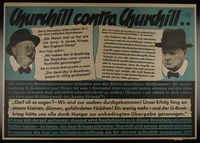
Nazi propaganda poster
Object
The Nazis used propaganda to buttress public support for the war effort, shape public opinion, and reinforce antisemitic ideas. As part of their propaganda campaign, the Nazis created the Word of the Week Series of posters (also referred to as Wandzeitung, or wall newspapers), the first of which was distributed on March 16, 1936. Each week, approximately 125,000 posters were strategically placed in public places and businesses such as: market squares, metro stations, bus stops, payroll offices, hospital waiting rooms, factory cafeterias, schools, hotels, restaurants, post offices, train stations, and street kiosks so that they would be viewed by as many people as possible. Posters were the primary medium for the series, but smaller pamphlets were also produced, which could be plastered on the back of correspondence. The posters used colorful, often derogatory caricatures, and photorealistic images with vibrant language to target the Nazis' early political adversaries, Jews, Communists, and Germany's enemies during the war. The series was discontinued in 1943.

Nazi propaganda poster
Object
The Nazis used propaganda to buttress public support for the war effort, shape public opinion, and reinforce antisemitic ideas. As part of their propaganda campaign, the Nazis created the Word of the Week Series of posters (also referred to as Wandzeitung, or wall newspapers), the first of which was distributed on March 16, 1936. Each week, approximately 125,000 posters were strategically placed in public places and businesses such as: market squares, metro stations, bus stops, payroll offices, hospital waiting rooms, factory cafeterias, schools, hotels, restaurants, post offices, train stations, and street kiosks so that they would be viewed by as many people as possible. Posters were the primary medium for the series, but smaller pamphlets were also produced, which could be plastered on the back of correspondence. The posters used colorful, often derogatory caricatures, and photorealistic images with vibrant language to target the Nazis' early political adversaries, Jews, Communists, and Germany's enemies during the war. The series was discontinued in 1943.
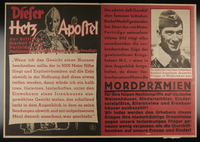
Nazi propaganda poster
Object
The Nazis used propaganda to buttress public support for the war effort, shape public opinion, and reinforce antisemitic ideas. As part of their propaganda campaign, the Nazis created the Word of the Week Series of posters (also referred to as Wandzeitung, or wall newspapers), the first of which was distributed on March 16, 1936. Each week, approximately 125,000 posters were strategically placed in public places and businesses such as: market squares, metro stations, bus stops, payroll offices, hospital waiting rooms, factory cafeterias, schools, hotels, restaurants, post offices, train stations, and street kiosks so that they would be viewed by as many people as possible. Posters were the primary medium for the series, but smaller pamphlets were also produced, which could be plastered on the back of correspondence. The posters used colorful, often derogatory caricatures, and photorealistic images with vibrant language to target the Nazis' early political adversaries, Jews, Communists, and Germany's enemies during the war. The series was discontinued in 1943.
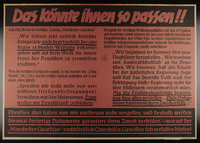
Nazi propaganda poster
Object
The Nazis used propaganda to buttress public support for the war effort, shape public opinion, and reinforce antisemitic ideas. As part of their propaganda campaign, the Nazis created the Word of the Week Series of posters (also referred to as Wandzeitung, or wall newspapers), the first of which was distributed on March 16, 1936. Each week, approximately 125,000 posters were strategically placed in public places and businesses such as: market squares, metro stations, bus stops, payroll offices, hospital waiting rooms, factory cafeterias, schools, hotels, restaurants, post offices, train stations, and street kiosks so that they would be viewed by as many people as possible. Posters were the primary medium for the series, but smaller pamphlets were also produced, which could be plastered on the back of correspondence. The posters used colorful, often derogatory caricatures, and photorealistic images with vibrant language to target the Nazis' early political adversaries, Jews, Communists, and Germany's enemies during the war. The series was discontinued in 1943.
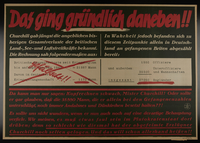
Nazi propaganda poster
Object
The Nazis used propaganda to buttress public support for the war effort, shape public opinion, and reinforce antisemitic ideas. As part of their propaganda campaign, the Nazis created the Word of the Week Series of posters (also referred to as Wandzeitung, or wall newspapers), the first of which was distributed on March 16, 1936. Each week, approximately 125,000 posters were strategically placed in public places and businesses such as: market squares, metro stations, bus stops, payroll offices, hospital waiting rooms, factory cafeterias, schools, hotels, restaurants, post offices, train stations, and street kiosks so that they would be viewed by as many people as possible. Posters were the primary medium for the series, but smaller pamphlets were also produced, which could be plastered on the back of correspondence. The posters used colorful, often derogatory caricatures, and photorealistic images with vibrant language to target the Nazis' early political adversaries, Jews, Communists, and Germany's enemies during the war. The series was discontinued in 1943.

Nazi propaganda poster
Object
The Nazis used propaganda to buttress public support for the war effort, shape public opinion, and reinforce antisemitic ideas. As part of their propaganda campaign, the Nazis created the Word of the Week Series of posters (also referred to as Wandzeitung, or wall newspapers), the first of which was distributed on March 16, 1936. Each week, approximately 125,000 posters were strategically placed in public places and businesses such as: market squares, metro stations, bus stops, payroll offices, hospital waiting rooms, factory cafeterias, schools, hotels, restaurants, post offices, train stations, and street kiosks so that they would be viewed by as many people as possible. Posters were the primary medium for the series, but smaller pamphlets were also produced, which could be plastered on the back of correspondence. The posters used colorful, often derogatory caricatures, and photorealistic images with vibrant language to target the Nazis' early political adversaries, Jews, Communists, and Germany's enemies during the war. The series was discontinued in 1943.
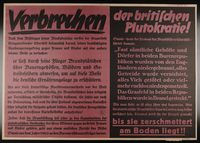
Nazi propaganda poster
Object
The Nazis used propaganda to buttress public support for the war effort, shape public opinion, and reinforce antisemitic ideas. As part of their propaganda campaign, the Nazis created the Word of the Week Series of posters (also referred to as Wandzeitung, or wall newspapers), the first of which was distributed on March 16, 1936. Each week, approximately 125,000 posters were strategically placed in public places and businesses such as: market squares, metro stations, bus stops, payroll offices, hospital waiting rooms, factory cafeterias, schools, hotels, restaurants, post offices, train stations, and street kiosks so that they would be viewed by as many people as possible. Posters were the primary medium for the series, but smaller pamphlets were also produced, which could be plastered on the back of correspondence. The posters used colorful, often derogatory caricatures, and photorealistic images with vibrant language to target the Nazis' early political adversaries, Jews, Communists, and Germany's enemies during the war. The series was discontinued in 1943.
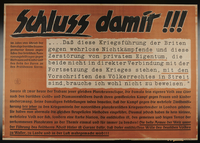
Nazi propaganda poster
Object
The Nazis used propaganda to buttress public support for the war effort, shape public opinion, and reinforce antisemitic ideas. As part of their propaganda campaign, the Nazis created the Word of the Week Series of posters (also referred to as Wandzeitung, or wall newspapers), the first of which was distributed on March 16, 1936. Each week, approximately 125,000 posters were strategically placed in public places and businesses such as: market squares, metro stations, bus stops, payroll offices, hospital waiting rooms, factory cafeterias, schools, hotels, restaurants, post offices, train stations, and street kiosks so that they would be viewed by as many people as possible. Posters were the primary medium for the series, but smaller pamphlets were also produced, which could be plastered on the back of correspondence. The posters used colorful, often derogatory caricatures, and photorealistic images with vibrant language to target the Nazis' early political adversaries, Jews, Communists, and Germany's enemies during the war. The series was discontinued in 1943.
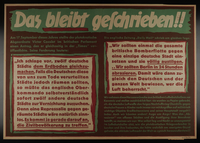
Nazi propaganda poster
Object
The Nazis used propaganda to buttress public support for the war effort, shape public opinion, and reinforce antisemitic ideas. As part of their propaganda campaign, the Nazis created the Word of the Week Series of posters (also referred to as Wandzeitung, or wall newspapers), the first of which was distributed on March 16, 1936. Each week, approximately 125,000 posters were strategically placed in public places and businesses such as: market squares, metro stations, bus stops, payroll offices, hospital waiting rooms, factory cafeterias, schools, hotels, restaurants, post offices, train stations, and street kiosks so that they would be viewed by as many people as possible. Posters were the primary medium for the series, but smaller pamphlets were also produced, which could be plastered on the back of correspondence. The posters used colorful, often derogatory caricatures, and photorealistic images with vibrant language to target the Nazis' early political adversaries, Jews, Communists, and Germany's enemies during the war. The series was discontinued in 1943.
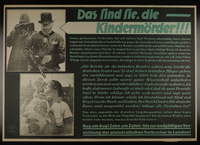
Nazi propaganda poster
Object
The Nazis used propaganda to buttress public support for the war effort, shape public opinion, and reinforce antisemitic ideas. As part of their propaganda campaign, the Nazis created the Word of the Week Series of posters (also referred to as Wandzeitung, or wall newspapers), the first of which was distributed on March 16, 1936. Each week, approximately 125,000 posters were strategically placed in public places and businesses such as: market squares, metro stations, bus stops, payroll offices, hospital waiting rooms, factory cafeterias, schools, hotels, restaurants, post offices, train stations, and street kiosks so that they would be viewed by as many people as possible. Posters were the primary medium for the series, but smaller pamphlets were also produced, which could be plastered on the back of correspondence. The posters used colorful, often derogatory caricatures, and photorealistic images with vibrant language to target the Nazis' early political adversaries, Jews, Communists, and Germany's enemies during the war. The series was discontinued in 1943.
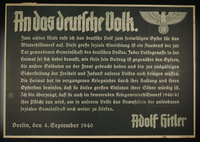
Nazi propaganda poster
Object
The Nazis used propaganda to buttress public support for the war effort, shape public opinion, and reinforce antisemitic ideas. As part of their propaganda campaign, the Nazis created the Word of the Week Series of posters (also referred to as Wandzeitung, or wall newspapers), the first of which was distributed on March 16, 1936. Each week, approximately 125,000 posters were strategically placed in public places and businesses such as: market squares, metro stations, bus stops, payroll offices, hospital waiting rooms, factory cafeterias, schools, hotels, restaurants, post offices, train stations, and street kiosks so that they would be viewed by as many people as possible. Posters were the primary medium for the series, but smaller pamphlets were also produced, which could be plastered on the back of correspondence. The posters used colorful, often derogatory caricatures, and photorealistic images with vibrant language to target the Nazis' early political adversaries, Jews, Communists, and Germany's enemies during the war. The series was discontinued in 1943.
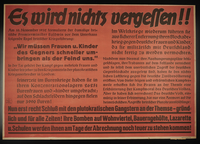
Nazi propaganda poster
Object
The Nazis used propaganda to buttress public support for the war effort, shape public opinion, and reinforce antisemitic ideas. As part of their propaganda campaign, the Nazis created the Word of the Week Series of posters (also referred to as Wandzeitung, or wall newspapers), the first of which was distributed on March 16, 1936. Each week, approximately 125,000 posters were strategically placed in public places and businesses such as: market squares, metro stations, bus stops, payroll offices, hospital waiting rooms, factory cafeterias, schools, hotels, restaurants, post offices, train stations, and street kiosks so that they would be viewed by as many people as possible. Posters were the primary medium for the series, but smaller pamphlets were also produced, which could be plastered on the back of correspondence. The posters used colorful, often derogatory caricatures, and photorealistic images with vibrant language to target the Nazis' early political adversaries, Jews, Communists, and Germany's enemies during the war. The series was discontinued in 1943.
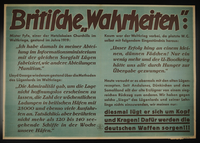
Nazi propaganda poster
Object
The Nazis used propaganda to buttress public support for the war effort, shape public opinion, and reinforce antisemitic ideas. As part of their propaganda campaign, the Nazis created the Word of the Week Series of posters (also referred to as Wandzeitung, or wall newspapers), the first of which was distributed on March 16, 1936. Each week, approximately 125,000 posters were strategically placed in public places and businesses such as: market squares, metro stations, bus stops, payroll offices, hospital waiting rooms, factory cafeterias, schools, hotels, restaurants, post offices, train stations, and street kiosks so that they would be viewed by as many people as possible. Posters were the primary medium for the series, but smaller pamphlets were also produced, which could be plastered on the back of correspondence. The posters used colorful, often derogatory caricatures, and photorealistic images with vibrant language to target the Nazis' early political adversaries, Jews, Communists, and Germany's enemies during the war. The series was discontinued in 1943.
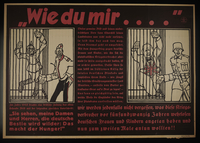
Nazi propaganda poster
Object
The Nazis used propaganda to buttress public support for the war effort, shape public opinion, and reinforce antisemitic ideas. As part of their propaganda campaign, the Nazis created the Word of the Week Series of posters (also referred to as Wandzeitung, or wall newspapers), the first of which was distributed on March 16, 1936. Each week, approximately 125,000 posters were strategically placed in public places and businesses such as: market squares, metro stations, bus stops, payroll offices, hospital waiting rooms, factory cafeterias, schools, hotels, restaurants, post offices, train stations, and street kiosks so that they would be viewed by as many people as possible. Posters were the primary medium for the series, but smaller pamphlets were also produced, which could be plastered on the back of correspondence. The posters used colorful, often derogatory caricatures, and photorealistic images with vibrant language to target the Nazis' early political adversaries, Jews, Communists, and Germany's enemies during the war. The series was discontinued in 1943.
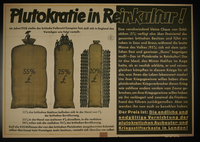
Nazi propaganda poster
Object
The Nazis used propaganda to buttress public support for the war effort, shape public opinion, and reinforce antisemitic ideas. As part of their propaganda campaign, the Nazis created the Word of the Week Series of posters (also referred to as Wandzeitung, or wall newspapers), the first of which was distributed on March 16, 1936. Each week, approximately 125,000 posters were strategically placed in public places and businesses such as: market squares, metro stations, bus stops, payroll offices, hospital waiting rooms, factory cafeterias, schools, hotels, restaurants, post offices, train stations, and street kiosks so that they would be viewed by as many people as possible. Posters were the primary medium for the series, but smaller pamphlets were also produced, which could be plastered on the back of correspondence. The posters used colorful, often derogatory caricatures, and photorealistic images with vibrant language to target the Nazis' early political adversaries, Jews, Communists, and Germany's enemies during the war. The series was discontinued in 1943.

Nazi propaganda poster
Object
The Nazis used propaganda to buttress public support for the war effort, shape public opinion, and reinforce antisemitic ideas. As part of their propaganda campaign, the Nazis created the Word of the Week Series of posters (also referred to as Wandzeitung, or wall newspapers), the first of which was distributed on March 16, 1936. Each week, approximately 125,000 posters were strategically placed in public places and businesses such as: market squares, metro stations, bus stops, payroll offices, hospital waiting rooms, factory cafeterias, schools, hotels, restaurants, post offices, train stations, and street kiosks so that they would be viewed by as many people as possible. Posters were the primary medium for the series, but smaller pamphlets were also produced, which could be plastered on the back of correspondence. The posters used colorful, often derogatory caricatures, and photorealistic images with vibrant language to target the Nazis' early political adversaries, Jews, Communists, and Germany's enemies during the war. The series was discontinued in 1943.
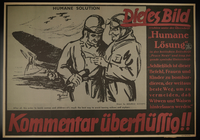
Nazi propaganda poster
Object
The Nazis used propaganda to buttress public support for the war effort, shape public opinion, and reinforce antisemitic ideas. As part of their propaganda campaign, the Nazis created the Word of the Week Series of posters (also referred to as Wandzeitung, or wall newspapers), the first of which was distributed on March 16, 1936. Each week, approximately 125,000 posters were strategically placed in public places and businesses such as: market squares, metro stations, bus stops, payroll offices, hospital waiting rooms, factory cafeterias, schools, hotels, restaurants, post offices, train stations, and street kiosks so that they would be viewed by as many people as possible. Posters were the primary medium for the series, but smaller pamphlets were also produced, which could be plastered on the back of correspondence. The posters used colorful, often derogatory caricatures, and photorealistic images with vibrant language to target the Nazis' early political adversaries, Jews, Communists, and Germany's enemies during the war. The series was discontinued in 1943.
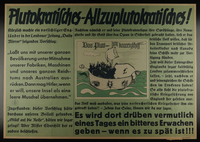
Nazi propaganda poster
Object
The Nazis used propaganda to buttress public support for the war effort, shape public opinion, and reinforce antisemitic ideas. As part of their propaganda campaign, the Nazis created the Word of the Week Series of posters (also referred to as Wandzeitung, or wall newspapers), the first of which was distributed on March 16, 1936. Each week, approximately 125,000 posters were strategically placed in public places and businesses such as: market squares, metro stations, bus stops, payroll offices, hospital waiting rooms, factory cafeterias, schools, hotels, restaurants, post offices, train stations, and street kiosks so that they would be viewed by as many people as possible. Posters were the primary medium for the series, but smaller pamphlets were also produced, which could be plastered on the back of correspondence. The posters used colorful, often derogatory caricatures, and photorealistic images with vibrant language to target the Nazis' early political adversaries, Jews, Communists, and Germany's enemies during the war. The series was discontinued in 1943.
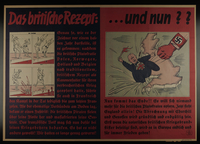
Nazi propaganda poster
Object
The Nazis used propaganda to buttress public support for the war effort, shape public opinion, and reinforce antisemitic ideas. As part of their propaganda campaign, the Nazis created the Word of the Week Series of posters (also referred to as Wandzeitung, or wall newspapers), the first of which was distributed on March 16, 1936. Each week, approximately 125,000 posters were strategically placed in public places and businesses such as: market squares, metro stations, bus stops, payroll offices, hospital waiting rooms, factory cafeterias, schools, hotels, restaurants, post offices, train stations, and street kiosks so that they would be viewed by as many people as possible. Posters were the primary medium for the series, but smaller pamphlets were also produced, which could be plastered on the back of correspondence. The posters used colorful, often derogatory caricatures, and photorealistic images with vibrant language to target the Nazis' early political adversaries, Jews, Communists, and Germany's enemies during the war. The series was discontinued in 1943.

Nazi propaganda poster
Object
The Nazis used propaganda to buttress public support for the war effort, shape public opinion, and reinforce antisemitic ideas. As part of their propaganda campaign, the Nazis created the Word of the Week Series of posters (also referred to as Wandzeitung, or wall newspapers), the first of which was distributed on March 16, 1936. Each week, approximately 125,000 posters were strategically placed in public places and businesses such as: market squares, metro stations, bus stops, payroll offices, hospital waiting rooms, factory cafeterias, schools, hotels, restaurants, post offices, train stations, and street kiosks so that they would be viewed by as many people as possible. Posters were the primary medium for the series, but smaller pamphlets were also produced, which could be plastered on the back of correspondence. The posters used colorful, often derogatory caricatures, and photorealistic images with vibrant language to target the Nazis' early political adversaries, Jews, Communists, and Germany's enemies during the war. The series was discontinued in 1943.
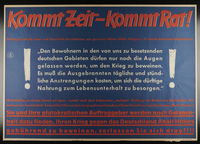
Nazi propaganda poster
Object
The Nazis used propaganda to buttress public support for the war effort, shape public opinion, and reinforce antisemitic ideas. As part of their propaganda campaign, the Nazis created the Word of the Week Series of posters (also referred to as Wandzeitung, or wall newspapers), the first of which was distributed on March 16, 1936. Each week, approximately 125,000 posters were strategically placed in public places and businesses such as: market squares, metro stations, bus stops, payroll offices, hospital waiting rooms, factory cafeterias, schools, hotels, restaurants, post offices, train stations, and street kiosks so that they would be viewed by as many people as possible. Posters were the primary medium for the series, but smaller pamphlets were also produced, which could be plastered on the back of correspondence. The posters used colorful, often derogatory caricatures, and photorealistic images with vibrant language to target the Nazis' early political adversaries, Jews, Communists, and Germany's enemies during the war. The series was discontinued in 1943.
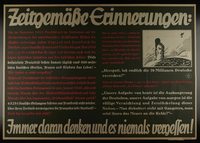
Nazi propaganda poster
Object
The Nazis used propaganda to buttress public support for the war effort, shape public opinion, and reinforce antisemitic ideas. As part of their propaganda campaign, the Nazis created the Word of the Week Series of posters (also referred to as Wandzeitung, or wall newspapers), the first of which was distributed on March 16, 1936. Each week, approximately 125,000 posters were strategically placed in public places and businesses such as: market squares, metro stations, bus stops, payroll offices, hospital waiting rooms, factory cafeterias, schools, hotels, restaurants, post offices, train stations, and street kiosks so that they would be viewed by as many people as possible. Posters were the primary medium for the series, but smaller pamphlets were also produced, which could be plastered on the back of correspondence. The posters used colorful, often derogatory caricatures, and photorealistic images with vibrant language to target the Nazis' early political adversaries, Jews, Communists, and Germany's enemies during the war. The series was discontinued in 1943.
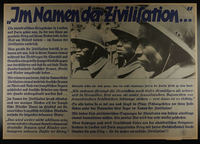
Nazi propaganda poster
Object
The Nazis used propaganda to buttress public support for the war effort, shape public opinion, and reinforce antisemitic ideas. As part of their propaganda campaign, the Nazis created the Word of the Week Series of posters (also referred to as Wandzeitung, or wall newspapers), the first of which was distributed on March 16, 1936. Each week, approximately 125,000 posters were strategically placed in public places and businesses such as: market squares, metro stations, bus stops, payroll offices, hospital waiting rooms, factory cafeterias, schools, hotels, restaurants, post offices, train stations, and street kiosks so that they would be viewed by as many people as possible. Posters were the primary medium for the series, but smaller pamphlets were also produced, which could be plastered on the back of correspondence. The posters used colorful, often derogatory caricatures, and photorealistic images with vibrant language to target the Nazis' early political adversaries, Jews, Communists, and Germany's enemies during the war. The series was discontinued in 1943.
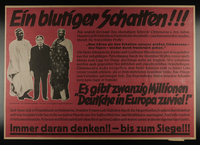
Nazi propaganda poster
Object
The Nazis used propaganda to buttress public support for the war effort, shape public opinion, and reinforce antisemitic ideas. As part of their propaganda campaign, the Nazis created the Word of the Week Series of posters (also referred to as Wandzeitung, or wall newspapers), the first of which was distributed on March 16, 1936. Each week, approximately 125,000 posters were strategically placed in public places and businesses such as: market squares, metro stations, bus stops, payroll offices, hospital waiting rooms, factory cafeterias, schools, hotels, restaurants, post offices, train stations, and street kiosks so that they would be viewed by as many people as possible. Posters were the primary medium for the series, but smaller pamphlets were also produced, which could be plastered on the back of correspondence. The posters used colorful, often derogatory caricatures, and photorealistic images with vibrant language to target the Nazis' early political adversaries, Jews, Communists, and Germany's enemies during the war. The series was discontinued in 1943.
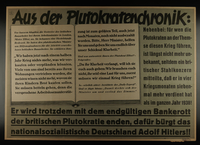
Nazi propaganda poster
Object
The Nazis used propaganda to buttress public support for the war effort, shape public opinion, and reinforce antisemitic ideas. As part of their propaganda campaign, the Nazis created the Word of the Week Series of posters (also referred to as Wandzeitung, or wall newspapers), the first of which was distributed on March 16, 1936. Each week, approximately 125,000 posters were strategically placed in public places and businesses such as: market squares, metro stations, bus stops, payroll offices, hospital waiting rooms, factory cafeterias, schools, hotels, restaurants, post offices, train stations, and street kiosks so that they would be viewed by as many people as possible. Posters were the primary medium for the series, but smaller pamphlets were also produced, which could be plastered on the back of correspondence. The posters used colorful, often derogatory caricatures, and photorealistic images with vibrant language to target the Nazis' early political adversaries, Jews, Communists, and Germany's enemies during the war. The series was discontinued in 1943.

Nazi propaganda poster
Object
The Nazis used propaganda to buttress public support for the war effort, shape public opinion, and reinforce antisemitic ideas. As part of their propaganda campaign, the Nazis created the Word of the Week Series of posters (also referred to as Wandzeitung, or wall newspapers), the first of which was distributed on March 16, 1936. Each week, approximately 125,000 posters were strategically placed in public places and businesses such as: market squares, metro stations, bus stops, payroll offices, hospital waiting rooms, factory cafeterias, schools, hotels, restaurants, post offices, train stations, and street kiosks so that they would be viewed by as many people as possible. Posters were the primary medium for the series, but smaller pamphlets were also produced, which could be plastered on the back of correspondence. The posters used colorful, often derogatory caricatures, and photorealistic images with vibrant language to target the Nazis' early political adversaries, Jews, Communists, and Germany's enemies during the war. The series was discontinued in 1943.
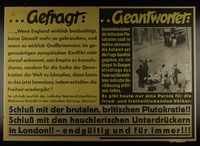
Nazi propaganda poster
Object
The Nazis used propaganda to buttress public support for the war effort, shape public opinion, and reinforce antisemitic ideas. As part of their propaganda campaign, the Nazis created the Word of the Week Series of posters (also referred to as Wandzeitung, or wall newspapers), the first of which was distributed on March 16, 1936. Each week, approximately 125,000 posters were strategically placed in public places and businesses such as: market squares, metro stations, bus stops, payroll offices, hospital waiting rooms, factory cafeterias, schools, hotels, restaurants, post offices, train stations, and street kiosks so that they would be viewed by as many people as possible. Posters were the primary medium for the series, but smaller pamphlets were also produced, which could be plastered on the back of correspondence. The posters used colorful, often derogatory caricatures, and photorealistic images with vibrant language to target the Nazis' early political adversaries, Jews, Communists, and Germany's enemies during the war. The series was discontinued in 1943.
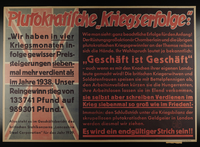
Nazi propaganda poster
Object
The Nazis used propaganda to buttress public support for the war effort, shape public opinion, and reinforce antisemitic ideas. As part of their propaganda campaign, the Nazis created the Word of the Week Series of posters (also referred to as Wandzeitung, or wall newspapers), the first of which was distributed on March 16, 1936. Each week, approximately 125,000 posters were strategically placed in public places and businesses such as: market squares, metro stations, bus stops, payroll offices, hospital waiting rooms, factory cafeterias, schools, hotels, restaurants, post offices, train stations, and street kiosks so that they would be viewed by as many people as possible. Posters were the primary medium for the series, but smaller pamphlets were also produced, which could be plastered on the back of correspondence. The posters used colorful, often derogatory caricatures, and photorealistic images with vibrant language to target the Nazis' early political adversaries, Jews, Communists, and Germany's enemies during the war. The series was discontinued in 1943.
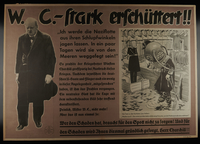
Nazi propaganda poster
Object
The Nazis used propaganda to buttress public support for the war effort, shape public opinion, and reinforce antisemitic ideas. As part of their propaganda campaign, the Nazis created the Word of the Week Series of posters (also referred to as Wandzeitung, or wall newspapers), the first of which was distributed on March 16, 1936. Each week, approximately 125,000 posters were strategically placed in public places and businesses such as: market squares, metro stations, bus stops, payroll offices, hospital waiting rooms, factory cafeterias, schools, hotels, restaurants, post offices, train stations, and street kiosks so that they would be viewed by as many people as possible. Posters were the primary medium for the series, but smaller pamphlets were also produced, which could be plastered on the back of correspondence. The posters used colorful, often derogatory caricatures, and photorealistic images with vibrant language to target the Nazis' early political adversaries, Jews, Communists, and Germany's enemies during the war. The series was discontinued in 1943.
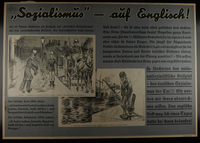
Nazi propaganda poster
Object
The Nazis used propaganda to buttress public support for the war effort, shape public opinion, and reinforce antisemitic ideas. As part of their propaganda campaign, the Nazis created the Word of the Week Series of posters (also referred to as Wandzeitung, or wall newspapers), the first of which was distributed on March 16, 1936. Each week, approximately 125,000 posters were strategically placed in public places and businesses such as: market squares, metro stations, bus stops, payroll offices, hospital waiting rooms, factory cafeterias, schools, hotels, restaurants, post offices, train stations, and street kiosks so that they would be viewed by as many people as possible. Posters were the primary medium for the series, but smaller pamphlets were also produced, which could be plastered on the back of correspondence. The posters used colorful, often derogatory caricatures, and photorealistic images with vibrant language to target the Nazis' early political adversaries, Jews, Communists, and Germany's enemies during the war. The series was discontinued in 1943.

Nazi propaganda poster
Object
The Nazis used propaganda to buttress public support for the war effort, shape public opinion, and reinforce antisemitic ideas. As part of their propaganda campaign, the Nazis created the Word of the Week Series of posters (also referred to as Wandzeitung, or wall newspapers), the first of which was distributed on March 16, 1936. Each week, approximately 125,000 posters were strategically placed in public places and businesses such as: market squares, metro stations, bus stops, payroll offices, hospital waiting rooms, factory cafeterias, schools, hotels, restaurants, post offices, train stations, and street kiosks so that they would be viewed by as many people as possible. Posters were the primary medium for the series, but smaller pamphlets were also produced, which could be plastered on the back of correspondence. The posters used colorful, often derogatory caricatures, and photorealistic images with vibrant language to target the Nazis' early political adversaries, Jews, Communists, and Germany's enemies during the war. The series was discontinued in 1943.
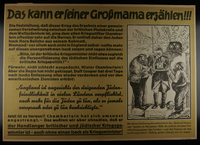
Nazi propaganda poster
Object
The Nazis used propaganda to buttress public support for the war effort, shape public opinion, and reinforce antisemitic ideas. As part of their propaganda campaign, the Nazis created the Word of the Week Series of posters (also referred to as Wandzeitung, or wall newspapers), the first of which was distributed on March 16, 1936. Each week, approximately 125,000 posters were strategically placed in public places and businesses such as: market squares, metro stations, bus stops, payroll offices, hospital waiting rooms, factory cafeterias, schools, hotels, restaurants, post offices, train stations, and street kiosks so that they would be viewed by as many people as possible. Posters were the primary medium for the series, but smaller pamphlets were also produced, which could be plastered on the back of correspondence. The posters used colorful, often derogatory caricatures, and photorealistic images with vibrant language to target the Nazis' early political adversaries, Jews, Communists, and Germany's enemies during the war. The series was discontinued in 1943.
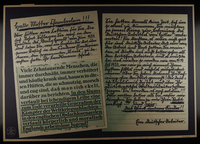
Nazi propaganda poster
Object
The Nazis used propaganda to buttress public support for the war effort, shape public opinion, and reinforce antisemitic ideas. As part of their propaganda campaign, the Nazis created the Word of the Week Series of posters (also referred to as Wandzeitung, or wall newspapers), the first of which was distributed on March 16, 1936. Each week, approximately 125,000 posters were strategically placed in public places and businesses such as: market squares, metro stations, bus stops, payroll offices, hospital waiting rooms, factory cafeterias, schools, hotels, restaurants, post offices, train stations, and street kiosks so that they would be viewed by as many people as possible. Posters were the primary medium for the series, but smaller pamphlets were also produced, which could be plastered on the back of correspondence. The posters used colorful, often derogatory caricatures, and photorealistic images with vibrant language to target the Nazis' early political adversaries, Jews, Communists, and Germany's enemies during the war. The series was discontinued in 1943.
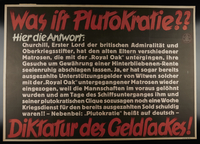
Nazi propaganda poster
Object
The Nazis used propaganda to buttress public support for the war effort, shape public opinion, and reinforce antisemitic ideas. As part of their propaganda campaign, the Nazis created the Word of the Week Series of posters (also referred to as Wandzeitung, or wall newspapers), the first of which was distributed on March 16, 1936. Each week, approximately 125,000 posters were strategically placed in public places and businesses such as: market squares, metro stations, bus stops, payroll offices, hospital waiting rooms, factory cafeterias, schools, hotels, restaurants, post offices, train stations, and street kiosks so that they would be viewed by as many people as possible. Posters were the primary medium for the series, but smaller pamphlets were also produced, which could be plastered on the back of correspondence. The posters used colorful, often derogatory caricatures, and photorealistic images with vibrant language to target the Nazis' early political adversaries, Jews, Communists, and Germany's enemies during the war. The series was discontinued in 1943.

Nazi propaganda poster
Object
The Nazis used propaganda to buttress public support for the war effort, shape public opinion, and reinforce antisemitic ideas. As part of their propaganda campaign, the Nazis created the Word of the Week Series of posters (also referred to as Wandzeitung, or wall newspapers), the first of which was distributed on March 16, 1936. Each week, approximately 125,000 posters were strategically placed in public places and businesses such as: market squares, metro stations, bus stops, payroll offices, hospital waiting rooms, factory cafeterias, schools, hotels, restaurants, post offices, train stations, and street kiosks so that they would be viewed by as many people as possible. Posters were the primary medium for the series, but smaller pamphlets were also produced, which could be plastered on the back of correspondence. The posters used colorful, often derogatory caricatures, and photorealistic images with vibrant language to target the Nazis' early political adversaries, Jews, Communists, and Germany's enemies during the war. The series was discontinued in 1943.
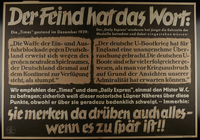
Nazi propaganda poster
Object
The Nazis used propaganda to buttress public support for the war effort, shape public opinion, and reinforce antisemitic ideas. As part of their propaganda campaign, the Nazis created the Word of the Week Series of posters (also referred to as Wandzeitung, or wall newspapers), the first of which was distributed on March 16, 1936. Each week, approximately 125,000 posters were strategically placed in public places and businesses such as: market squares, metro stations, bus stops, payroll offices, hospital waiting rooms, factory cafeterias, schools, hotels, restaurants, post offices, train stations, and street kiosks so that they would be viewed by as many people as possible. Posters were the primary medium for the series, but smaller pamphlets were also produced, which could be plastered on the back of correspondence. The posters used colorful, often derogatory caricatures, and photorealistic images with vibrant language to target the Nazis' early political adversaries, Jews, Communists, and Germany's enemies during the war. The series was discontinued in 1943.
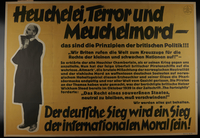
Nazi propaganda poster
Object
The Nazis used propaganda to buttress public support for the war effort, shape public opinion, and reinforce antisemitic ideas. As part of their propaganda campaign, the Nazis created the Word of the Week Series of posters (also referred to as Wandzeitung, or wall newspapers), the first of which was distributed on March 16, 1936. Each week, approximately 125,000 posters were strategically placed in public places and businesses such as: market squares, metro stations, bus stops, payroll offices, hospital waiting rooms, factory cafeterias, schools, hotels, restaurants, post offices, train stations, and street kiosks so that they would be viewed by as many people as possible. Posters were the primary medium for the series, but smaller pamphlets were also produced, which could be plastered on the back of correspondence. The posters used colorful, often derogatory caricatures, and photorealistic images with vibrant language to target the Nazis' early political adversaries, Jews, Communists, and Germany's enemies during the war. The series was discontinued in 1943.
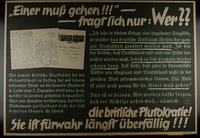
Nazi propaganda poster
Object
The Nazis used propaganda to buttress public support for the war effort, shape public opinion, and reinforce antisemitic ideas. As part of their propaganda campaign, the Nazis created the Word of the Week Series of posters (also referred to as Wandzeitung, or wall newspapers), the first of which was distributed on March 16, 1936. Each week, approximately 125,000 posters were strategically placed in public places and businesses such as: market squares, metro stations, bus stops, payroll offices, hospital waiting rooms, factory cafeterias, schools, hotels, restaurants, post offices, train stations, and street kiosks so that they would be viewed by as many people as possible. Posters were the primary medium for the series, but smaller pamphlets were also produced, which could be plastered on the back of correspondence. The posters used colorful, often derogatory caricatures, and photorealistic images with vibrant language to target the Nazis' early political adversaries, Jews, Communists, and Germany's enemies during the war. The series was discontinued in 1943.
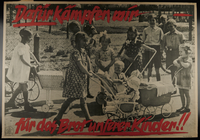
Nazi propaganda poster
Object
The Nazis used propaganda to buttress public support for the war effort, shape public opinion, and reinforce antisemitic ideas. As part of their propaganda campaign, the Nazis created the Word of the Week Series of posters (also referred to as Wandzeitung, or wall newspapers), the first of which was distributed on March 16, 1936. Each week, approximately 125,000 posters were strategically placed in public places and businesses such as: market squares, metro stations, bus stops, payroll offices, hospital waiting rooms, factory cafeterias, schools, hotels, restaurants, post offices, train stations, and street kiosks so that they would be viewed by as many people as possible. Posters were the primary medium for the series, but smaller pamphlets were also produced, which could be plastered on the back of correspondence. The posters used colorful, often derogatory caricatures, and photorealistic images with vibrant language to target the Nazis' early political adversaries, Jews, Communists, and Germany's enemies during the war. The series was discontinued in 1943.
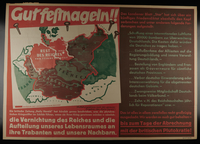
Nazi propaganda poster
Object
The Nazis used propaganda to buttress public support for the war effort, shape public opinion, and reinforce antisemitic ideas. As part of their propaganda campaign, the Nazis created the Word of the Week Series of posters (also referred to as Wandzeitung, or wall newspapers), the first of which was distributed on March 16, 1936. Each week, approximately 125,000 posters were strategically placed in public places and businesses such as: market squares, metro stations, bus stops, payroll offices, hospital waiting rooms, factory cafeterias, schools, hotels, restaurants, post offices, train stations, and street kiosks so that they would be viewed by as many people as possible. Posters were the primary medium for the series, but smaller pamphlets were also produced, which could be plastered on the back of correspondence. The posters used colorful, often derogatory caricatures, and photorealistic images with vibrant language to target the Nazis' early political adversaries, Jews, Communists, and Germany's enemies during the war. The series was discontinued in 1943.
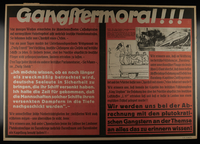
Nazi propaganda poster
Object
The Nazis used propaganda to buttress public support for the war effort, shape public opinion, and reinforce antisemitic ideas. As part of their propaganda campaign, the Nazis created the Word of the Week Series of posters (also referred to as Wandzeitung, or wall newspapers), the first of which was distributed on March 16, 1936. Each week, approximately 125,000 posters were strategically placed in public places and businesses such as: market squares, metro stations, bus stops, payroll offices, hospital waiting rooms, factory cafeterias, schools, hotels, restaurants, post offices, train stations, and street kiosks so that they would be viewed by as many people as possible. Posters were the primary medium for the series, but smaller pamphlets were also produced, which could be plastered on the back of correspondence. The posters used colorful, often derogatory caricatures, and photorealistic images with vibrant language to target the Nazis' early political adversaries, Jews, Communists, and Germany's enemies during the war. The series was discontinued in 1943.
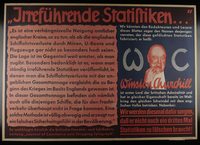
Nazi propaganda poster
Object
The Nazis used propaganda to buttress public support for the war effort, shape public opinion, and reinforce antisemitic ideas. As part of their propaganda campaign, the Nazis created the Word of the Week Series of posters (also referred to as Wandzeitung, or wall newspapers), the first of which was distributed on March 16, 1936. Each week, approximately 125,000 posters were strategically placed in public places and businesses such as: market squares, metro stations, bus stops, payroll offices, hospital waiting rooms, factory cafeterias, schools, hotels, restaurants, post offices, train stations, and street kiosks so that they would be viewed by as many people as possible. Posters were the primary medium for the series, but smaller pamphlets were also produced, which could be plastered on the back of correspondence. The posters used colorful, often derogatory caricatures, and photorealistic images with vibrant language to target the Nazis' early political adversaries, Jews, Communists, and Germany's enemies during the war. The series was discontinued in 1943.
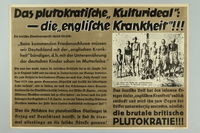
Nazi propaganda poster
Object
The Nazis used propaganda to buttress public support for the war effort, shape public opinion, and reinforce antisemitic ideas. As part of their propaganda campaign, the Nazis created the Word of the Week Series of posters (also referred to as Wandzeitung, or wall newspapers), the first of which was distributed on March 16, 1936. Each week, approximately 125,000 posters were strategically placed in public places and businesses such as: market squares, metro stations, bus stops, payroll offices, hospital waiting rooms, factory cafeterias, schools, hotels, restaurants, post offices, train stations, and street kiosks so that they would be viewed by as many people as possible. Posters were the primary medium for the series, but smaller pamphlets were also produced, which could be plastered on the back of correspondence. The posters used colorful, often derogatory caricatures, and photorealistic images with vibrant language to target the Nazis' early political adversaries, Jews, Communists, and Germany's enemies during the war. The series was discontinued in 1943.
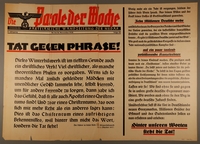
Nazi propaganda poster
Object
The Nazis used propaganda to buttress public support for the war effort, shape public opinion, and reinforce antisemitic ideas. As part of their propaganda campaign, the Nazis created the Word of the Week Series of posters (also referred to as Wandzeitung, or wall newspapers), the first of which was distributed on March 16, 1936. Each week, approximately 125,000 posters were strategically placed in public places and businesses such as: market squares, metro stations, bus stops, payroll offices, hospital waiting rooms, factory cafeterias, schools, hotels, restaurants, post offices, train stations, and street kiosks so that they would be viewed by as many people as possible. Posters were the primary medium for the series, but smaller pamphlets were also produced, which could be plastered on the back of correspondence. The posters used colorful, often derogatory caricatures, and photorealistic images with vibrant language to target the Nazis' early political adversaries, Jews, Communists, and Germany's enemies during the war. The series was discontinued in 1943.
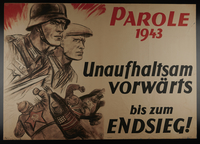
German Word of the Week propaganda poster declaring the inevitability of victory
Object
German propaganda poster likely issued from January 3 to 16, 1943, from the Parole der Woche (Word of the Week) series, showing a German soldier and civilian pushing forward against Germany’s Soviet, American, British, and Jewish enemies. By January 1943, Germany’s invasion of the Soviet Union had stalled in the face of Soviet opposition, and German forces in North Africa were being worn down by Allied forces. The Nazis used propaganda to buttress public support for the war effort, shape public opinion, and reinforce antisemitic ideas. As part of their propaganda campaign, the Nazis created the Word of the Week Series of posters (also referred to as Wandzeitung, or wall newspapers), the first of which was distributed on March 16, 1936. Each week, approximately 125,000 posters were strategically placed in public places and businesses such as: market squares, metro stations, bus stops, payroll offices, hospital waiting rooms, factory cafeterias, schools, hotels, restaurants, post offices, train stations, and street kiosks so that they would be viewed by as many people as possible. Posters were the primary medium for the series, but smaller pamphlets were also produced, which could be plastered on the back of correspondence. The posters used colorful, often derogatory caricatures, and photorealistic images with vibrant language to target the Nazis’ early political adversaries, Jews, Communists, and Germany’s enemies during the war. The series was discontinued in 1943.

Nazi propaganda poster
Object
The Nazis used propaganda to buttress public support for the war effort, shape public opinion, and reinforce antisemitic ideas. As part of their propaganda campaign, the Nazis created the Word of the Week Series of posters (also referred to as Wandzeitung, or wall newspapers), the first of which was distributed on March 16, 1936. Each week, approximately 125,000 posters were strategically placed in public places and businesses such as: market squares, metro stations, bus stops, payroll offices, hospital waiting rooms, factory cafeterias, schools, hotels, restaurants, post offices, train stations, and street kiosks so that they would be viewed by as many people as possible. Posters were the primary medium for the series, but smaller pamphlets were also produced, which could be plastered on the back of correspondence. The posters used colorful, often derogatory caricatures, and photorealistic images with vibrant language to target the Nazis' early political adversaries, Jews, Communists, and Germany's enemies during the war. The series was discontinued in 1943.

Nazi propaganda poster
Object
The Nazis used propaganda to buttress public support for the war effort, shape public opinion, and reinforce antisemitic ideas. As part of their propaganda campaign, the Nazis created the Word of the Week Series of posters (also referred to as Wandzeitung, or wall newspapers), the first of which was distributed on March 16, 1936. Each week, approximately 125,000 posters were strategically placed in public places and businesses such as: market squares, metro stations, bus stops, payroll offices, hospital waiting rooms, factory cafeterias, schools, hotels, restaurants, post offices, train stations, and street kiosks so that they would be viewed by as many people as possible. Posters were the primary medium for the series, but smaller pamphlets were also produced, which could be plastered on the back of correspondence. The posters used colorful, often derogatory caricatures, and photorealistic images with vibrant language to target the Nazis' early political adversaries, Jews, Communists, and Germany's enemies during the war. The series was discontinued in 1943.

Nazi propaganda poster
Object
The Nazis used propaganda to buttress public support for the war effort, shape public opinion, and reinforce antisemitic ideas. As part of their propaganda campaign, the Nazis created the Word of the Week Series of posters (also referred to as Wandzeitung, or wall newspapers), the first of which was distributed on March 16, 1936. Each week, approximately 125,000 posters were strategically placed in public places and businesses such as: market squares, metro stations, bus stops, payroll offices, hospital waiting rooms, factory cafeterias, schools, hotels, restaurants, post offices, train stations, and street kiosks so that they would be viewed by as many people as possible. Posters were the primary medium for the series, but smaller pamphlets were also produced, which could be plastered on the back of correspondence. The posters used colorful, often derogatory caricatures, and photorealistic images with vibrant language to target the Nazis' early political adversaries, Jews, Communists, and Germany's enemies during the war. The series was discontinued in 1943.
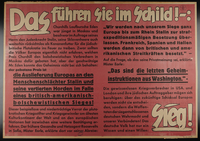
Nazi propaganda poster
Object
The Nazis used propaganda to buttress public support for the war effort, shape public opinion, and reinforce antisemitic ideas. As part of their propaganda campaign, the Nazis created the Word of the Week Series of posters (also referred to as Wandzeitung, or wall newspapers), the first of which was distributed on March 16, 1936. Each week, approximately 125,000 posters were strategically placed in public places and businesses such as: market squares, metro stations, bus stops, payroll offices, hospital waiting rooms, factory cafeterias, schools, hotels, restaurants, post offices, train stations, and street kiosks so that they would be viewed by as many people as possible. Posters were the primary medium for the series, but smaller pamphlets were also produced, which could be plastered on the back of correspondence. The posters used colorful, often derogatory caricatures, and photorealistic images with vibrant language to target the Nazis' early political adversaries, Jews, Communists, and Germany's enemies during the war. The series was discontinued in 1943.

Text only Nazi propaganda poster denouncing Churchill
Object
The Nazis used propaganda to buttress public support for the war effort, shape public opinion, and reinforce antisemitic ideas. As part of their propaganda campaign, the Nazis created the Word of the Week Series of posters (also referred to as Wandzeitung, or wall newspapers), the first of which was distributed on March 16, 1936. Each week, approximately 125,000 posters were strategically placed in public places and businesses such as: market squares, metro stations, bus stops, payroll offices, hospital waiting rooms, factory cafeterias, schools, hotels, restaurants, post offices, train stations, and street kiosks so that they would be viewed by as many people as possible. Posters were the primary medium for the series, but smaller pamphlets were also produced, which could be plastered on the back of correspondence. The posters used colorful, often derogatory caricatures, and photorealistic images with vibrant language to target the Nazis' early political adversaries, Jews, Communists, and Germany's enemies during the war. The series was discontinued in 1943.
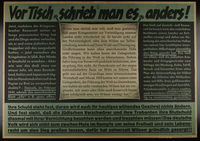
Nazi propaganda poster
Object
The Nazis used propaganda to buttress public support for the war effort, shape public opinion, and reinforce antisemitic ideas. As part of their propaganda campaign, the Nazis created the Word of the Week Series of posters (also referred to as Wandzeitung, or wall newspapers), the first of which was distributed on March 16, 1936. Each week, approximately 125,000 posters were strategically placed in public places and businesses such as: market squares, metro stations, bus stops, payroll offices, hospital waiting rooms, factory cafeterias, schools, hotels, restaurants, post offices, train stations, and street kiosks so that they would be viewed by as many people as possible. Posters were the primary medium for the series, but smaller pamphlets were also produced, which could be plastered on the back of correspondence. The posters used colorful, often derogatory caricatures, and photorealistic images with vibrant language to target the Nazis' early political adversaries, Jews, Communists, and Germany's enemies during the war. The series was discontinued in 1943.
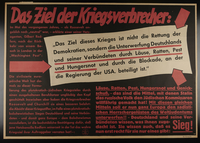
Nazi propaganda poster
Object
The Nazis used propaganda to buttress public support for the war effort, shape public opinion, and reinforce antisemitic ideas. As part of their propaganda campaign, the Nazis created the Word of the Week Series of posters (also referred to as Wandzeitung, or wall newspapers), the first of which was distributed on March 16, 1936. Each week, approximately 125,000 posters were strategically placed in public places and businesses such as: market squares, metro stations, bus stops, payroll offices, hospital waiting rooms, factory cafeterias, schools, hotels, restaurants, post offices, train stations, and street kiosks so that they would be viewed by as many people as possible. Posters were the primary medium for the series, but smaller pamphlets were also produced, which could be plastered on the back of correspondence. The posters used colorful, often derogatory caricatures, and photorealistic images with vibrant language to target the Nazis' early political adversaries, Jews, Communists, and Germany's enemies during the war. The series was discontinued in 1943.
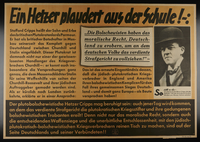
Nazi propaganda poster
Object
The Nazis used propaganda to buttress public support for the war effort, shape public opinion, and reinforce antisemitic ideas. As part of their propaganda campaign, the Nazis created the Word of the Week Series of posters (also referred to as Wandzeitung, or wall newspapers), the first of which was distributed on March 16, 1936. Each week, approximately 125,000 posters were strategically placed in public places and businesses such as: market squares, metro stations, bus stops, payroll offices, hospital waiting rooms, factory cafeterias, schools, hotels, restaurants, post offices, train stations, and street kiosks so that they would be viewed by as many people as possible. Posters were the primary medium for the series, but smaller pamphlets were also produced, which could be plastered on the back of correspondence. The posters used colorful, often derogatory caricatures, and photorealistic images with vibrant language to target the Nazis' early political adversaries, Jews, Communists, and Germany's enemies during the war. The series was discontinued in 1943.
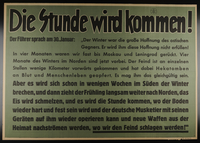
Nazi propaganda poster
Object
The Nazis used propaganda to buttress public support for the war effort, shape public opinion, and reinforce antisemitic ideas. As part of their propaganda campaign, the Nazis created the Word of the Week Series of posters (also referred to as Wandzeitung, or wall newspapers), the first of which was distributed on March 16, 1936. Each week, approximately 125,000 posters were strategically placed in public places and businesses such as: market squares, metro stations, bus stops, payroll offices, hospital waiting rooms, factory cafeterias, schools, hotels, restaurants, post offices, train stations, and street kiosks so that they would be viewed by as many people as possible. Posters were the primary medium for the series, but smaller pamphlets were also produced, which could be plastered on the back of correspondence. The posters used colorful, often derogatory caricatures, and photorealistic images with vibrant language to target the Nazis' early political adversaries, Jews, Communists, and Germany's enemies during the war. The series was discontinued in 1943.
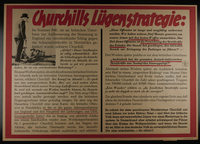
Nazi propaganda poster
Object
The Nazis used propaganda to buttress public support for the war effort, shape public opinion, and reinforce antisemitic ideas. As part of their propaganda campaign, the Nazis created the Word of the Week Series of posters (also referred to as Wandzeitung, or wall newspapers), the first of which was distributed on March 16, 1936. Each week, approximately 125,000 posters were strategically placed in public places and businesses such as: market squares, metro stations, bus stops, payroll offices, hospital waiting rooms, factory cafeterias, schools, hotels, restaurants, post offices, train stations, and street kiosks so that they would be viewed by as many people as possible. Posters were the primary medium for the series, but smaller pamphlets were also produced, which could be plastered on the back of correspondence. The posters used colorful, often derogatory caricatures, and photorealistic images with vibrant language to target the Nazis' early political adversaries, Jews, Communists, and Germany's enemies during the war. The series was discontinued in 1943.
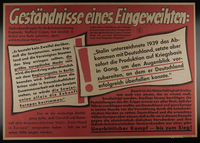
Nazi propaganda poster
Object
The Nazis used propaganda to buttress public support for the war effort, shape public opinion, and reinforce antisemitic ideas. As part of their propaganda campaign, the Nazis created the Word of the Week Series of posters (also referred to as Wandzeitung, or wall newspapers), the first of which was distributed on March 16, 1936. Each week, approximately 125,000 posters were strategically placed in public places and businesses such as: market squares, metro stations, bus stops, payroll offices, hospital waiting rooms, factory cafeterias, schools, hotels, restaurants, post offices, train stations, and street kiosks so that they would be viewed by as many people as possible. Posters were the primary medium for the series, but smaller pamphlets were also produced, which could be plastered on the back of correspondence. The posters used colorful, often derogatory caricatures, and photorealistic images with vibrant language to target the Nazis' early political adversaries, Jews, Communists, and Germany's enemies during the war. The series was discontinued in 1943.

Nazi propaganda poster
Object
The Nazis used propaganda to buttress public support for the war effort, shape public opinion, and reinforce antisemitic ideas. As part of their propaganda campaign, the Nazis created the Word of the Week Series of posters (also referred to as Wandzeitung, or wall newspapers), the first of which was distributed on March 16, 1936. Each week, approximately 125,000 posters were strategically placed in public places and businesses such as: market squares, metro stations, bus stops, payroll offices, hospital waiting rooms, factory cafeterias, schools, hotels, restaurants, post offices, train stations, and street kiosks so that they would be viewed by as many people as possible. Posters were the primary medium for the series, but smaller pamphlets were also produced, which could be plastered on the back of correspondence. The posters used colorful, often derogatory caricatures, and photorealistic images with vibrant language to target the Nazis' early political adversaries, Jews, Communists, and Germany's enemies during the war. The series was discontinued in 1943.
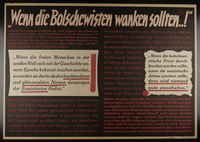
Nazi propaganda poster
Object
The Nazis used propaganda to buttress public support for the war effort, shape public opinion, and reinforce antisemitic ideas. As part of their propaganda campaign, the Nazis created the Word of the Week Series of posters (also referred to as Wandzeitung, or wall newspapers), the first of which was distributed on March 16, 1936. Each week, approximately 125,000 posters were strategically placed in public places and businesses such as: market squares, metro stations, bus stops, payroll offices, hospital waiting rooms, factory cafeterias, schools, hotels, restaurants, post offices, train stations, and street kiosks so that they would be viewed by as many people as possible. Posters were the primary medium for the series, but smaller pamphlets were also produced, which could be plastered on the back of correspondence. The posters used colorful, often derogatory caricatures, and photorealistic images with vibrant language to target the Nazis' early political adversaries, Jews, Communists, and Germany's enemies during the war. The series was discontinued in 1943.
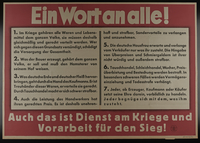
Nazi propaganda poster
Object
The Nazis used propaganda to buttress public support for the war effort, shape public opinion, and reinforce antisemitic ideas. As part of their propaganda campaign, the Nazis created the Word of the Week Series of posters (also referred to as Wandzeitung, or wall newspapers), the first of which was distributed on March 16, 1936. Each week, approximately 125,000 posters were strategically placed in public places and businesses such as: market squares, metro stations, bus stops, payroll offices, hospital waiting rooms, factory cafeterias, schools, hotels, restaurants, post offices, train stations, and street kiosks so that they would be viewed by as many people as possible. Posters were the primary medium for the series, but smaller pamphlets were also produced, which could be plastered on the back of correspondence. The posters used colorful, often derogatory caricatures, and photorealistic images with vibrant language to target the Nazis' early political adversaries, Jews, Communists, and Germany's enemies during the war. The series was discontinued in 1943.
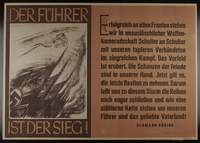
Nazi propaganda poster
Object
The Nazis used propaganda to buttress public support for the war effort, shape public opinion, and reinforce antisemitic ideas. As part of their propaganda campaign, the Nazis created the Word of the Week Series of posters (also referred to as Wandzeitung, or wall newspapers), the first of which was distributed on March 16, 1936. Each week, approximately 125,000 posters were strategically placed in public places and businesses such as: market squares, metro stations, bus stops, payroll offices, hospital waiting rooms, factory cafeterias, schools, hotels, restaurants, post offices, train stations, and street kiosks so that they would be viewed by as many people as possible. Posters were the primary medium for the series, but smaller pamphlets were also produced, which could be plastered on the back of correspondence. The posters used colorful, often derogatory caricatures, and photorealistic images with vibrant language to target the Nazis' early political adversaries, Jews, Communists, and Germany's enemies during the war. The series was discontinued in 1943.
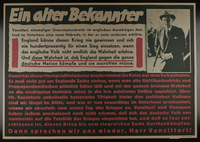
Nazi propaganda poster
Object
The Nazis used propaganda to buttress public support for the war effort, shape public opinion, and reinforce antisemitic ideas. As part of their propaganda campaign, the Nazis created the Word of the Week Series of posters (also referred to as Wandzeitung, or wall newspapers), the first of which was distributed on March 16, 1936. Each week, approximately 125,000 posters were strategically placed in public places and businesses such as: market squares, metro stations, bus stops, payroll offices, hospital waiting rooms, factory cafeterias, schools, hotels, restaurants, post offices, train stations, and street kiosks so that they would be viewed by as many people as possible. Posters were the primary medium for the series, but smaller pamphlets were also produced, which could be plastered on the back of correspondence. The posters used colorful, often derogatory caricatures, and photorealistic images with vibrant language to target the Nazis' early political adversaries, Jews, Communists, and Germany's enemies during the war. The series was discontinued in 1943.

Nazi propaganda poster
Object
The Nazis used propaganda to buttress public support for the war effort, shape public opinion, and reinforce antisemitic ideas. As part of their propaganda campaign, the Nazis created the Word of the Week Series of posters (also referred to as Wandzeitung, or wall newspapers), the first of which was distributed on March 16, 1936. Each week, approximately 125,000 posters were strategically placed in public places and businesses such as: market squares, metro stations, bus stops, payroll offices, hospital waiting rooms, factory cafeterias, schools, hotels, restaurants, post offices, train stations, and street kiosks so that they would be viewed by as many people as possible. Posters were the primary medium for the series, but smaller pamphlets were also produced, which could be plastered on the back of correspondence. The posters used colorful, often derogatory caricatures, and photorealistic images with vibrant language to target the Nazis' early political adversaries, Jews, Communists, and Germany's enemies during the war. The series was discontinued in 1943.

Nazi propaganda poster
Object
The Nazis used propaganda to buttress public support for the war effort, shape public opinion, and reinforce antisemitic ideas. As part of their propaganda campaign, the Nazis created the Word of the Week Series of posters (also referred to as Wandzeitung, or wall newspapers), the first of which was distributed on March 16, 1936. Each week, approximately 125,000 posters were strategically placed in public places and businesses such as: market squares, metro stations, bus stops, payroll offices, hospital waiting rooms, factory cafeterias, schools, hotels, restaurants, post offices, train stations, and street kiosks so that they would be viewed by as many people as possible. Posters were the primary medium for the series, but smaller pamphlets were also produced, which could be plastered on the back of correspondence. The posters used colorful, often derogatory caricatures, and photorealistic images with vibrant language to target the Nazis' early political adversaries, Jews, Communists, and Germany's enemies during the war. The series was discontinued in 1943.
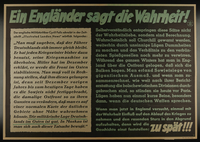
Nazi propaganda poster
Object
The Nazis used propaganda to buttress public support for the war effort, shape public opinion, and reinforce antisemitic ideas. As part of their propaganda campaign, the Nazis created the Word of the Week Series of posters (also referred to as Wandzeitung, or wall newspapers), the first of which was distributed on March 16, 1936. Each week, approximately 125,000 posters were strategically placed in public places and businesses such as: market squares, metro stations, bus stops, payroll offices, hospital waiting rooms, factory cafeterias, schools, hotels, restaurants, post offices, train stations, and street kiosks so that they would be viewed by as many people as possible. Posters were the primary medium for the series, but smaller pamphlets were also produced, which could be plastered on the back of correspondence. The posters used colorful, often derogatory caricatures, and photorealistic images with vibrant language to target the Nazis' early political adversaries, Jews, Communists, and Germany's enemies during the war. The series was discontinued in 1943.
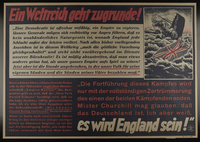
Nazi propaganda poster
Object
The Nazis used propaganda to buttress public support for the war effort, shape public opinion, and reinforce antisemitic ideas. As part of their propaganda campaign, the Nazis created the Word of the Week Series of posters (also referred to as Wandzeitung, or wall newspapers), the first of which was distributed on March 16, 1936. Each week, approximately 125,000 posters were strategically placed in public places and businesses such as: market squares, metro stations, bus stops, payroll offices, hospital waiting rooms, factory cafeterias, schools, hotels, restaurants, post offices, train stations, and street kiosks so that they would be viewed by as many people as possible. Posters were the primary medium for the series, but smaller pamphlets were also produced, which could be plastered on the back of correspondence. The posters used colorful, often derogatory caricatures, and photorealistic images with vibrant language to target the Nazis' early political adversaries, Jews, Communists, and Germany's enemies during the war. The series was discontinued in 1943.

Nazi propaganda poster
Object
The Nazis used propaganda to buttress public support for the war effort, shape public opinion, and reinforce antisemitic ideas. As part of their propaganda campaign, the Nazis created the Word of the Week Series of posters (also referred to as Wandzeitung, or wall newspapers), the first of which was distributed on March 16, 1936. Each week, approximately 125,000 posters were strategically placed in public places and businesses such as: market squares, metro stations, bus stops, payroll offices, hospital waiting rooms, factory cafeterias, schools, hotels, restaurants, post offices, train stations, and street kiosks so that they would be viewed by as many people as possible. Posters were the primary medium for the series, but smaller pamphlets were also produced, which could be plastered on the back of correspondence. The posters used colorful, often derogatory caricatures, and photorealistic images with vibrant language to target the Nazis' early political adversaries, Jews, Communists, and Germany's enemies during the war. The series was discontinued in 1943.
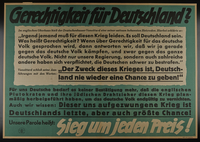
Nazi propaganda poster
Object
The Nazis used propaganda to buttress public support for the war effort, shape public opinion, and reinforce antisemitic ideas. As part of their propaganda campaign, the Nazis created the Word of the Week Series of posters (also referred to as Wandzeitung, or wall newspapers), the first of which was distributed on March 16, 1936. Each week, approximately 125,000 posters were strategically placed in public places and businesses such as: market squares, metro stations, bus stops, payroll offices, hospital waiting rooms, factory cafeterias, schools, hotels, restaurants, post offices, train stations, and street kiosks so that they would be viewed by as many people as possible. Posters were the primary medium for the series, but smaller pamphlets were also produced, which could be plastered on the back of correspondence. The posters used colorful, often derogatory caricatures, and photorealistic images with vibrant language to target the Nazis' early political adversaries, Jews, Communists, and Germany's enemies during the war. The series was discontinued in 1943.
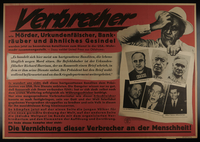
German propaganda poster claiming the United States Army is using criminals to fight in Germany
Object
German propaganda poster issued during the week of June 17 to June 23, 1942, from the Parole der Woche (Word of the Week) series. The poster depicts pictures of American criminals from the recent past, including: Al Capone, Thomas Pendergast, Robert Emmet O'Malley, Robert J. Boltz, and William P. Buckner. The text purports that United States President Franklin Roosevelt recruited criminals to serve in the American armed forces against Germany. It also accuses Roosevelt of being a money launderer, and claims he has a rapport with the criminal elements. The Nazis use this unfounded appraoch as evidence that America’s war on Germany is unjust and ignoring that Germany declared war on the U.S. The poster also attempts to justify the Nazi’s treatment of Jews by showing a captioned picture of a man called, “Louis the rabbi” along with the criminals, and claims that Jews are in league with organized crime. The Nazis used propaganda to buttress public support for the war effort, shape public opinion, and reinforce antisemitic ideas. As part of their propaganda campaign, the Nazis created the Word of the Week Series of posters (also referred to as Wandzeitung, or wall newspapers), which began distribution on March 16, 1936. Each week, new posters were placed in public places and businesses to be viewed by as many people as possible. Posters were the primary medium for the series, but smaller pamphlets were also produced, which could be plastered on the back of correspondences. The posters targeted the Nazis’ early political adversaries, Jews, Communists, and Germany’s enemies during the war. The series was discontinued in 1943.

Nazi propaganda poster
Object
The Nazis used propaganda to buttress public support for the war effort, shape public opinion, and reinforce antisemitic ideas. As part of their propaganda campaign, the Nazis created the Word of the Week Series of posters (also referred to as Wandzeitung, or wall newspapers), the first of which was distributed on March 16, 1936. Each week, approximately 125,000 posters were strategically placed in public places and businesses such as: market squares, metro stations, bus stops, payroll offices, hospital waiting rooms, factory cafeterias, schools, hotels, restaurants, post offices, train stations, and street kiosks so that they would be viewed by as many people as possible. Posters were the primary medium for the series, but smaller pamphlets were also produced, which could be plastered on the back of correspondence. The posters used colorful, often derogatory caricatures, and photorealistic images with vibrant language to target the Nazis' early political adversaries, Jews, Communists, and Germany's enemies during the war. The series was discontinued in 1943.
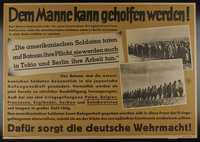
Nazi propaganda poster
Object
The Nazis used propaganda to buttress public support for the war effort, shape public opinion, and reinforce antisemitic ideas. As part of their propaganda campaign, the Nazis created the Word of the Week Series of posters (also referred to as Wandzeitung, or wall newspapers), the first of which was distributed on March 16, 1936. Each week, approximately 125,000 posters were strategically placed in public places and businesses such as: market squares, metro stations, bus stops, payroll offices, hospital waiting rooms, factory cafeterias, schools, hotels, restaurants, post offices, train stations, and street kiosks so that they would be viewed by as many people as possible. Posters were the primary medium for the series, but smaller pamphlets were also produced, which could be plastered on the back of correspondence. The posters used colorful, often derogatory caricatures, and photorealistic images with vibrant language to target the Nazis' early political adversaries, Jews, Communists, and Germany's enemies during the war. The series was discontinued in 1943.
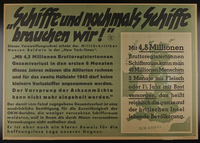
Nazi propaganda poster
Object
The Nazis used propaganda to buttress public support for the war effort, shape public opinion, and reinforce antisemitic ideas. As part of their propaganda campaign, the Nazis created the Word of the Week Series of posters (also referred to as Wandzeitung, or wall newspapers), the first of which was distributed on March 16, 1936. Each week, approximately 125,000 posters were strategically placed in public places and businesses such as: market squares, metro stations, bus stops, payroll offices, hospital waiting rooms, factory cafeterias, schools, hotels, restaurants, post offices, train stations, and street kiosks so that they would be viewed by as many people as possible. Posters were the primary medium for the series, but smaller pamphlets were also produced, which could be plastered on the back of correspondence. The posters used colorful, often derogatory caricatures, and photorealistic images with vibrant language to target the Nazis' early political adversaries, Jews, Communists, and Germany's enemies during the war. The series was discontinued in 1943.
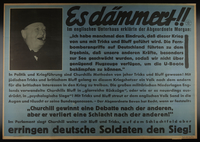
Nazi propaganda poster
Object
The Nazis used propaganda to buttress public support for the war effort, shape public opinion, and reinforce antisemitic ideas. As part of their propaganda campaign, the Nazis created the Word of the Week Series of posters (also referred to as Wandzeitung, or wall newspapers), the first of which was distributed on March 16, 1936. Each week, approximately 125,000 posters were strategically placed in public places and businesses such as: market squares, metro stations, bus stops, payroll offices, hospital waiting rooms, factory cafeterias, schools, hotels, restaurants, post offices, train stations, and street kiosks so that they would be viewed by as many people as possible. Posters were the primary medium for the series, but smaller pamphlets were also produced, which could be plastered on the back of correspondence. The posters used colorful, often derogatory caricatures, and photorealistic images with vibrant language to target the Nazis' early political adversaries, Jews, Communists, and Germany's enemies during the war. The series was discontinued in 1943.

Nazi propaganda poster
Object
The Nazis used propaganda to buttress public support for the war effort, shape public opinion, and reinforce antisemitic ideas. As part of their propaganda campaign, the Nazis created the Word of the Week Series of posters (also referred to as Wandzeitung, or wall newspapers), the first of which was distributed on March 16, 1936. Each week, approximately 125,000 posters were strategically placed in public places and businesses such as: market squares, metro stations, bus stops, payroll offices, hospital waiting rooms, factory cafeterias, schools, hotels, restaurants, post offices, train stations, and street kiosks so that they would be viewed by as many people as possible. Posters were the primary medium for the series, but smaller pamphlets were also produced, which could be plastered on the back of correspondence. The posters used colorful, often derogatory caricatures, and photorealistic images with vibrant language to target the Nazis' early political adversaries, Jews, Communists, and Germany's enemies during the war. The series was discontinued in 1943.
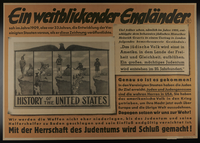
Nazi poster on the need to destroy the US-Jewish conspiracy to rule the world
Object
The Nazis used propaganda to buttress public support for the war effort, shape public opinion, and reinforce antisemitic ideas. As part of their propaganda campaign, the Nazis created the Word of the Week Series of posters (also referred to as Wandzeitung, or wall newspapers), the first of which was distributed on March 16, 1936. Each week, approximately 125,000 posters were strategically placed in public places and businesses such as: market squares, metro stations, bus stops, payroll offices, hospital waiting rooms, factory cafeterias, schools, hotels, restaurants, post offices, train stations, and street kiosks so that they would be viewed by as many people as possible. Posters were the primary medium for the series, but smaller pamphlets were also produced, which could be plastered on the back of correspondence. The posters used colorful, often derogatory caricatures, and photorealistic images with vibrant language to target the Nazis’ early political adversaries, Jews, Communists, and Germany’s enemies during the war. The series was discontinued in 1943.
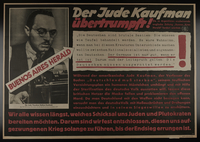
Nazi propaganda poster claiming American Jews want to exterminate the German people
Object
German propaganda poster issued during the week of August 19 to August 25, 1942, from the Parole der Woche (Word of the Week) series. This poster uses a quote from Theodore Kaufman’s book, “Germany Must Die,” and claims that the Jews and their allies are fighting to exterminate the German people. Theodore Kaufman was a fringe, Jewish-American extremist writer who advocated for the sterilization of German men and women as a means to eliminate the German people, and the partition of German territory among neighboring nations. Although his writings were not popular in America, the Nazis used them heavily in their propaganda to advocate for public support for the war. They falsely claimed that Kaufman’s ideas were popular opinion in America, and that Kaufman was an associate of President Roosevelt. The Nazis used propaganda to buttress public support for the war effort, shape public opinion, and reinforce antisemitic ideas. As part of their propaganda campaign, the Nazis created the Word of the Week Series of posters (also referred to as Wandzeitung, or wall newspapers), the first of which was distributed on March 16, 1936. Each week, approximately 125,000 posters were strategically placed in public places and businesses so that they would be viewed by as many people as possible. Posters were the primary medium for the series, but smaller pamphlets were also produced, which could be plastered on the back of correspondences. The posters used colorful, often derogatory caricatures, and photorealistic images with vibrant language to target the Nazis’ early political adversaries, Jews, Communists, and Germany’s enemies during the war. The series was discontinued in 1943.
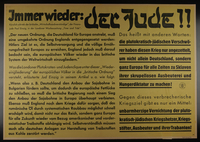
Nazi propaganda poster
Object
The Nazis used propaganda to buttress public support for the war effort, shape public opinion, and reinforce antisemitic ideas. As part of their propaganda campaign, the Nazis created the Word of the Week Series of posters (also referred to as Wandzeitung, or wall newspapers), the first of which was distributed on March 16, 1936. Each week, approximately 125,000 posters were strategically placed in public places and businesses such as: market squares, metro stations, bus stops, payroll offices, hospital waiting rooms, factory cafeterias, schools, hotels, restaurants, post offices, train stations, and street kiosks so that they would be viewed by as many people as possible. Posters were the primary medium for the series, but smaller pamphlets were also produced, which could be plastered on the back of correspondence. The posters used colorful, often derogatory caricatures, and photorealistic images with vibrant language to target the Nazis' early political adversaries, Jews, Communists, and Germany's enemies during the war. The series was discontinued in 1943.
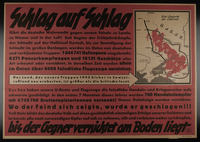
Nazi propaganda poster
Object
The Nazis used propaganda to buttress public support for the war effort, shape public opinion, and reinforce antisemitic ideas. As part of their propaganda campaign, the Nazis created the Word of the Week Series of posters (also referred to as Wandzeitung, or wall newspapers), the first of which was distributed on March 16, 1936. Each week, approximately 125,000 posters were strategically placed in public places and businesses such as: market squares, metro stations, bus stops, payroll offices, hospital waiting rooms, factory cafeterias, schools, hotels, restaurants, post offices, train stations, and street kiosks so that they would be viewed by as many people as possible. Posters were the primary medium for the series, but smaller pamphlets were also produced, which could be plastered on the back of correspondence. The posters used colorful, often derogatory caricatures, and photorealistic images with vibrant language to target the Nazis' early political adversaries, Jews, Communists, and Germany's enemies during the war. The series was discontinued in 1943.
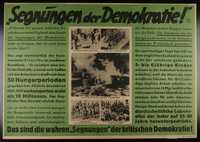
Nazi propaganda poster
Object
The Nazis used propaganda to buttress public support for the war effort, shape public opinion, and reinforce antisemitic ideas. As part of their propaganda campaign, the Nazis created the Word of the Week Series of posters (also referred to as Wandzeitung, or wall newspapers), the first of which was distributed on March 16, 1936. Each week, approximately 125,000 posters were strategically placed in public places and businesses such as: market squares, metro stations, bus stops, payroll offices, hospital waiting rooms, factory cafeterias, schools, hotels, restaurants, post offices, train stations, and street kiosks so that they would be viewed by as many people as possible. Posters were the primary medium for the series, but smaller pamphlets were also produced, which could be plastered on the back of correspondence. The posters used colorful, often derogatory caricatures, and photorealistic images with vibrant language to target the Nazis' early political adversaries, Jews, Communists, and Germany's enemies during the war. The series was discontinued in 1943.

Nazi propaganda poster
Object
The Nazis used propaganda to buttress public support for the war effort, shape public opinion, and reinforce antisemitic ideas. As part of their propaganda campaign, the Nazis created the Word of the Week Series of posters (also referred to as Wandzeitung, or wall newspapers), the first of which was distributed on March 16, 1936. Each week, approximately 125,000 posters were strategically placed in public places and businesses such as: market squares, metro stations, bus stops, payroll offices, hospital waiting rooms, factory cafeterias, schools, hotels, restaurants, post offices, train stations, and street kiosks so that they would be viewed by as many people as possible. Posters were the primary medium for the series, but smaller pamphlets were also produced, which could be plastered on the back of correspondence. The posters used colorful, often derogatory caricatures, and photorealistic images with vibrant language to target the Nazis' early political adversaries, Jews, Communists, and Germany's enemies during the war. The series was discontinued in 1943.
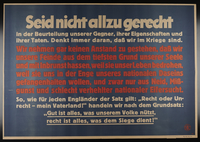
Nazi propaganda poster
Object
The Nazis used propaganda to buttress public support for the war effort, shape public opinion, and reinforce antisemitic ideas. As part of their propaganda campaign, the Nazis created the Word of the Week Series of posters (also referred to as Wandzeitung, or wall newspapers), the first of which was distributed on March 16, 1936. Each week, approximately 125,000 posters were strategically placed in public places and businesses such as: market squares, metro stations, bus stops, payroll offices, hospital waiting rooms, factory cafeterias, schools, hotels, restaurants, post offices, train stations, and street kiosks so that they would be viewed by as many people as possible. Posters were the primary medium for the series, but smaller pamphlets were also produced, which could be plastered on the back of correspondence. The posters used colorful, often derogatory caricatures, and photorealistic images with vibrant language to target the Nazis' early political adversaries, Jews, Communists, and Germany's enemies during the war. The series was discontinued in 1943.
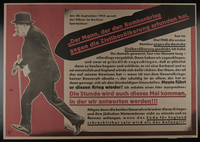
Nazi propaganda poster
Object
The Nazis used propaganda to buttress public support for the war effort, shape public opinion, and reinforce antisemitic ideas. As part of their propaganda campaign, the Nazis created the Word of the Week Series of posters (also referred to as Wandzeitung, or wall newspapers), the first of which was distributed on March 16, 1936. Each week, approximately 125,000 posters were strategically placed in public places and businesses such as: market squares, metro stations, bus stops, payroll offices, hospital waiting rooms, factory cafeterias, schools, hotels, restaurants, post offices, train stations, and street kiosks so that they would be viewed by as many people as possible. Posters were the primary medium for the series, but smaller pamphlets were also produced, which could be plastered on the back of correspondence. The posters used colorful, often derogatory caricatures, and photorealistic images with vibrant language to target the Nazis' early political adversaries, Jews, Communists, and Germany's enemies during the war. The series was discontinued in 1943.
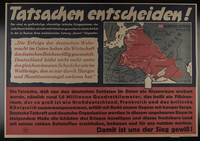
Nazi propaganda poster
Object
The Nazis used propaganda to buttress public support for the war effort, shape public opinion, and reinforce antisemitic ideas. As part of their propaganda campaign, the Nazis created the Word of the Week Series of posters (also referred to as Wandzeitung, or wall newspapers), the first of which was distributed on March 16, 1936. Each week, approximately 125,000 posters were strategically placed in public places and businesses such as: market squares, metro stations, bus stops, payroll offices, hospital waiting rooms, factory cafeterias, schools, hotels, restaurants, post offices, train stations, and street kiosks so that they would be viewed by as many people as possible. Posters were the primary medium for the series, but smaller pamphlets were also produced, which could be plastered on the back of correspondence. The posters used colorful, often derogatory caricatures, and photorealistic images with vibrant language to target the Nazis' early political adversaries, Jews, Communists, and Germany's enemies during the war. The series was discontinued in 1943.
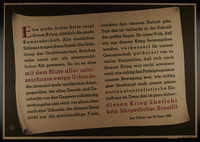
Nazi propaganda poster
Object
The Nazis used propaganda to buttress public support for the war effort, shape public opinion, and reinforce antisemitic ideas. As part of their propaganda campaign, the Nazis created the Word of the Week Series of posters (also referred to as Wandzeitung, or wall newspapers), the first of which was distributed on March 16, 1936. Each week, approximately 125,000 posters were strategically placed in public places and businesses such as: market squares, metro stations, bus stops, payroll offices, hospital waiting rooms, factory cafeterias, schools, hotels, restaurants, post offices, train stations, and street kiosks so that they would be viewed by as many people as possible. Posters were the primary medium for the series, but smaller pamphlets were also produced, which could be plastered on the back of correspondence. The posters used colorful, often derogatory caricatures, and photorealistic images with vibrant language to target the Nazis' early political adversaries, Jews, Communists, and Germany's enemies during the war. The series was discontinued in 1943.
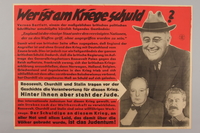
Nazi propaganda poster
Object
The Nazis used propaganda to buttress public support for the war effort, shape public opinion, and reinforce antisemitic ideas. As part of their propaganda campaign, the Nazis created the Word of the Week Series of posters (also referred to as Wandzeitung, or wall newspapers), the first of which was distributed on March 16, 1936. Each week, approximately 125,000 posters were strategically placed in public places and businesses such as: market squares, metro stations, bus stops, payroll offices, hospital waiting rooms, factory cafeterias, schools, hotels, restaurants, post offices, train stations, and street kiosks so that they would be viewed by as many people as possible. Posters were the primary medium for the series, but smaller pamphlets were also produced, which could be plastered on the back of correspondence. The posters used colorful, often derogatory caricatures, and photorealistic images with vibrant language to target the Nazis' early political adversaries, Jews, Communists, and Germany's enemies during the war. The series was discontinued in 1943.
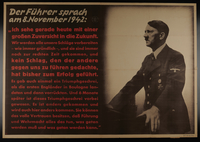
Nazi propaganda poster
Object
The Nazis used propaganda to buttress public support for the war effort, shape public opinion, and reinforce antisemitic ideas. As part of their propaganda campaign, the Nazis created the Word of the Week Series of posters (also referred to as Wandzeitung, or wall newspapers), the first of which was distributed on March 16, 1936. Each week, approximately 125,000 posters were strategically placed in public places and businesses such as: market squares, metro stations, bus stops, payroll offices, hospital waiting rooms, factory cafeterias, schools, hotels, restaurants, post offices, train stations, and street kiosks so that they would be viewed by as many people as possible. Posters were the primary medium for the series, but smaller pamphlets were also produced, which could be plastered on the back of correspondence. The posters used colorful, often derogatory caricatures, and photorealistic images with vibrant language to target the Nazis' early political adversaries, Jews, Communists, and Germany's enemies during the war. The series was discontinued in 1943.
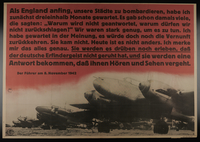
Nazi propaganda poster
Object
The Nazis used propaganda to buttress public support for the war effort, shape public opinion, and reinforce antisemitic ideas. As part of their propaganda campaign, the Nazis created the Word of the Week Series of posters (also referred to as Wandzeitung, or wall newspapers), the first of which was distributed on March 16, 1936. Each week, approximately 125,000 posters were strategically placed in public places and businesses such as: market squares, metro stations, bus stops, payroll offices, hospital waiting rooms, factory cafeterias, schools, hotels, restaurants, post offices, train stations, and street kiosks so that they would be viewed by as many people as possible. Posters were the primary medium for the series, but smaller pamphlets were also produced, which could be plastered on the back of correspondence. The posters used colorful, often derogatory caricatures, and photorealistic images with vibrant language to target the Nazis' early political adversaries, Jews, Communists, and Germany's enemies during the war. The series was discontinued in 1943.

Nazi propaganda poster
Object
The Nazis used propaganda to buttress public support for the war effort, shape public opinion, and reinforce antisemitic ideas. As part of their propaganda campaign, the Nazis created the Word of the Week Series of posters (also referred to as Wandzeitung, or wall newspapers), the first of which was distributed on March 16, 1936. Each week, approximately 125,000 posters were strategically placed in public places and businesses such as: market squares, metro stations, bus stops, payroll offices, hospital waiting rooms, factory cafeterias, schools, hotels, restaurants, post offices, train stations, and street kiosks so that they would be viewed by as many people as possible. Posters were the primary medium for the series, but smaller pamphlets were also produced, which could be plastered on the back of correspondence. The posters used colorful, often derogatory caricatures, and photorealistic images with vibrant language to target the Nazis' early political adversaries, Jews, Communists, and Germany's enemies during the war. The series was discontinued in 1943.
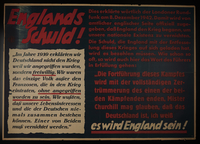
Nazi propaganda poster
Object
The Nazis used propaganda to buttress public support for the war effort, shape public opinion, and reinforce antisemitic ideas. As part of their propaganda campaign, the Nazis created the Word of the Week Series of posters (also referred to as Wandzeitung, or wall newspapers), the first of which was distributed on March 16, 1936. Each week, approximately 125,000 posters were strategically placed in public places and businesses such as: market squares, metro stations, bus stops, payroll offices, hospital waiting rooms, factory cafeterias, schools, hotels, restaurants, post offices, train stations, and street kiosks so that they would be viewed by as many people as possible. Posters were the primary medium for the series, but smaller pamphlets were also produced, which could be plastered on the back of correspondence. The posters used colorful, often derogatory caricatures, and photorealistic images with vibrant language to target the Nazis' early political adversaries, Jews, Communists, and Germany's enemies during the war. The series was discontinued in 1943.
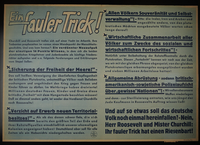
Nazi propaganda poster
Object
The Nazis used propaganda to buttress public support for the war effort, shape public opinion, and reinforce antisemitic ideas. As part of their propaganda campaign, the Nazis created the Word of the Week Series of posters (also referred to as Wandzeitung, or wall newspapers), the first of which was distributed on March 16, 1936. Each week, approximately 125,000 posters were strategically placed in public places and businesses such as: market squares, metro stations, bus stops, payroll offices, hospital waiting rooms, factory cafeterias, schools, hotels, restaurants, post offices, train stations, and street kiosks so that they would be viewed by as many people as possible. Posters were the primary medium for the series, but smaller pamphlets were also produced, which could be plastered on the back of correspondence. The posters used colorful, often derogatory caricatures, and photorealistic images with vibrant language to target the Nazis' early political adversaries, Jews, Communists, and Germany's enemies during the war. The series was discontinued in 1943.
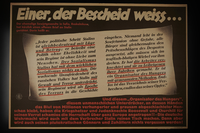
Nazi propaganda poster
Object
The Nazis used propaganda to buttress public support for the war effort, shape public opinion, and reinforce antisemitic ideas. As part of their propaganda campaign, the Nazis created the Word of the Week Series of posters (also referred to as Wandzeitung, or wall newspapers), the first of which was distributed on March 16, 1936. Each week, approximately 125,000 posters were strategically placed in public places and businesses such as: market squares, metro stations, bus stops, payroll offices, hospital waiting rooms, factory cafeterias, schools, hotels, restaurants, post offices, train stations, and street kiosks so that they would be viewed by as many people as possible. Posters were the primary medium for the series, but smaller pamphlets were also produced, which could be plastered on the back of correspondence. The posters used colorful, often derogatory caricatures, and photorealistic images with vibrant language to target the Nazis' early political adversaries, Jews, Communists, and Germany's enemies during the war. The series was discontinued in 1943.
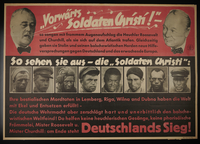
Nazi propaganda poster
Object
The Nazis used propaganda to buttress public support for the war effort, shape public opinion, and reinforce antisemitic ideas. As part of their propaganda campaign, the Nazis created the Word of the Week Series of posters (also referred to as Wandzeitung, or wall newspapers), the first of which was distributed on March 16, 1936. Each week, approximately 125,000 posters were strategically placed in public places and businesses such as: market squares, metro stations, bus stops, payroll offices, hospital waiting rooms, factory cafeterias, schools, hotels, restaurants, post offices, train stations, and street kiosks so that they would be viewed by as many people as possible. Posters were the primary medium for the series, but smaller pamphlets were also produced, which could be plastered on the back of correspondence. The posters used colorful, often derogatory caricatures, and photorealistic images with vibrant language to target the Nazis' early political adversaries, Jews, Communists, and Germany's enemies during the war. The series was discontinued in 1943.
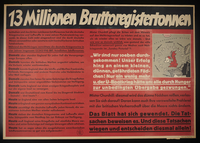
Nazi propaganda poster
Object
The Nazis used propaganda to buttress public support for the war effort, shape public opinion, and reinforce antisemitic ideas. As part of their propaganda campaign, the Nazis created the Word of the Week Series of posters (also referred to as Wandzeitung, or wall newspapers), the first of which was distributed on March 16, 1936. Each week, approximately 125,000 posters were strategically placed in public places and businesses such as: market squares, metro stations, bus stops, payroll offices, hospital waiting rooms, factory cafeterias, schools, hotels, restaurants, post offices, train stations, and street kiosks so that they would be viewed by as many people as possible. Posters were the primary medium for the series, but smaller pamphlets were also produced, which could be plastered on the back of correspondence. The posters used colorful, often derogatory caricatures, and photorealistic images with vibrant language to target the Nazis' early political adversaries, Jews, Communists, and Germany's enemies during the war. The series was discontinued in 1943.
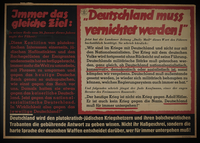
Nazi propaganda poster
Object
The Nazis used propaganda to buttress public support for the war effort, shape public opinion, and reinforce antisemitic ideas. As part of their propaganda campaign, the Nazis created the Word of the Week Series of posters (also referred to as Wandzeitung, or wall newspapers), the first of which was distributed on March 16, 1936. Each week, approximately 125,000 posters were strategically placed in public places and businesses such as: market squares, metro stations, bus stops, payroll offices, hospital waiting rooms, factory cafeterias, schools, hotels, restaurants, post offices, train stations, and street kiosks so that they would be viewed by as many people as possible. Posters were the primary medium for the series, but smaller pamphlets were also produced, which could be plastered on the back of correspondence. The posters used colorful, often derogatory caricatures, and photorealistic images with vibrant language to target the Nazis' early political adversaries, Jews, Communists, and Germany's enemies during the war. The series was discontinued in 1943.
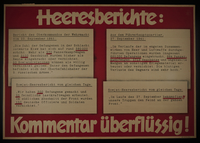
Nazi propaganda poster
Object
The Nazis used propaganda to buttress public support for the war effort, shape public opinion, and reinforce antisemitic ideas. As part of their propaganda campaign, the Nazis created the Word of the Week Series of posters (also referred to as Wandzeitung, or wall newspapers), the first of which was distributed on March 16, 1936. Each week, approximately 125,000 posters were strategically placed in public places and businesses such as: market squares, metro stations, bus stops, payroll offices, hospital waiting rooms, factory cafeterias, schools, hotels, restaurants, post offices, train stations, and street kiosks so that they would be viewed by as many people as possible. Posters were the primary medium for the series, but smaller pamphlets were also produced, which could be plastered on the back of correspondence. The posters used colorful, often derogatory caricatures, and photorealistic images with vibrant language to target the Nazis' early political adversaries, Jews, Communists, and Germany's enemies during the war. The series was discontinued in 1943.
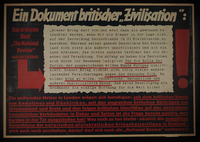
Nazi propaganda poster
Object
The Nazis used propaganda to buttress public support for the war effort, shape public opinion, and reinforce antisemitic ideas. As part of their propaganda campaign, the Nazis created the Word of the Week Series of posters (also referred to as Wandzeitung, or wall newspapers), the first of which was distributed on March 16, 1936. Each week, approximately 125,000 posters were strategically placed in public places and businesses such as: market squares, metro stations, bus stops, payroll offices, hospital waiting rooms, factory cafeterias, schools, hotels, restaurants, post offices, train stations, and street kiosks so that they would be viewed by as many people as possible. Posters were the primary medium for the series, but smaller pamphlets were also produced, which could be plastered on the back of correspondence. The posters used colorful, often derogatory caricatures, and photorealistic images with vibrant language to target the Nazis' early political adversaries, Jews, Communists, and Germany's enemies during the war. The series was discontinued in 1943.
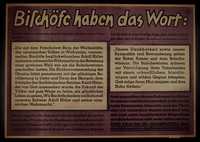
Nazi propaganda poster
Object
The Nazis used propaganda to buttress public support for the war effort, shape public opinion, and reinforce antisemitic ideas. As part of their propaganda campaign, the Nazis created the Word of the Week Series of posters (also referred to as Wandzeitung, or wall newspapers), the first of which was distributed on March 16, 1936. Each week, approximately 125,000 posters were strategically placed in public places and businesses such as: market squares, metro stations, bus stops, payroll offices, hospital waiting rooms, factory cafeterias, schools, hotels, restaurants, post offices, train stations, and street kiosks so that they would be viewed by as many people as possible. Posters were the primary medium for the series, but smaller pamphlets were also produced, which could be plastered on the back of correspondence. The posters used colorful, often derogatory caricatures, and photorealistic images with vibrant language to target the Nazis' early political adversaries, Jews, Communists, and Germany's enemies during the war. The series was discontinued in 1943.
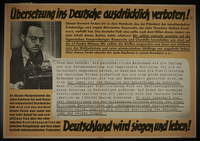
Nazi propaganda poster
Object
The Nazis used propaganda to buttress public support for the war effort, shape public opinion, and reinforce antisemitic ideas. As part of their propaganda campaign, the Nazis created the Word of the Week Series of posters (also referred to as Wandzeitung, or wall newspapers), the first of which was distributed on March 16, 1936. Each week, approximately 125,000 posters were strategically placed in public places and businesses such as: market squares, metro stations, bus stops, payroll offices, hospital waiting rooms, factory cafeterias, schools, hotels, restaurants, post offices, train stations, and street kiosks so that they would be viewed by as many people as possible. Posters were the primary medium for the series, but smaller pamphlets were also produced, which could be plastered on the back of correspondence. The posters used colorful, often derogatory caricatures, and photorealistic images with vibrant language to target the Nazis' early political adversaries, Jews, Communists, and Germany's enemies during the war. The series was discontinued in 1943.
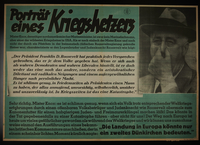
Nazi propaganda poster
Object
The Nazis used propaganda to buttress public support for the war effort, shape public opinion, and reinforce antisemitic ideas. As part of their propaganda campaign, the Nazis created the Word of the Week Series of posters (also referred to as Wandzeitung, or wall newspapers), the first of which was distributed on March 16, 1936. Each week, approximately 125,000 posters were strategically placed in public places and businesses such as: market squares, metro stations, bus stops, payroll offices, hospital waiting rooms, factory cafeterias, schools, hotels, restaurants, post offices, train stations, and street kiosks so that they would be viewed by as many people as possible. Posters were the primary medium for the series, but smaller pamphlets were also produced, which could be plastered on the back of correspondence. The posters used colorful, often derogatory caricatures, and photorealistic images with vibrant language to target the Nazis' early political adversaries, Jews, Communists, and Germany's enemies during the war. The series was discontinued in 1943.
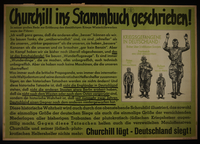
Nazi propaganda poster
Object
The Nazis used propaganda to buttress public support for the war effort, shape public opinion, and reinforce antisemitic ideas. As part of their propaganda campaign, the Nazis created the Word of the Week Series of posters (also referred to as Wandzeitung, or wall newspapers), the first of which was distributed on March 16, 1936. Each week, approximately 125,000 posters were strategically placed in public places and businesses such as: market squares, metro stations, bus stops, payroll offices, hospital waiting rooms, factory cafeterias, schools, hotels, restaurants, post offices, train stations, and street kiosks so that they would be viewed by as many people as possible. Posters were the primary medium for the series, but smaller pamphlets were also produced, which could be plastered on the back of correspondence. The posters used colorful, often derogatory caricatures, and photorealistic images with vibrant language to target the Nazis' early political adversaries, Jews, Communists, and Germany's enemies during the war. The series was discontinued in 1943.

Nazi propaganda poster
Object
The Nazis used propaganda to buttress public support for the war effort, shape public opinion, and reinforce antisemitic ideas. As part of their propaganda campaign, the Nazis created the Word of the Week Series of posters (also referred to as Wandzeitung, or wall newspapers), the first of which was distributed on March 16, 1936. Each week, approximately 125,000 posters were strategically placed in public places and businesses such as: market squares, metro stations, bus stops, payroll offices, hospital waiting rooms, factory cafeterias, schools, hotels, restaurants, post offices, train stations, and street kiosks so that they would be viewed by as many people as possible. Posters were the primary medium for the series, but smaller pamphlets were also produced, which could be plastered on the back of correspondence. The posters used colorful, often derogatory caricatures, and photorealistic images with vibrant language to target the Nazis' early political adversaries, Jews, Communists, and Germany's enemies during the war. The series was discontinued in 1943.
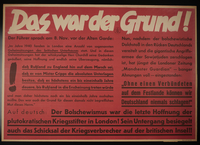
Nazi propaganda poster
Object
The Nazis used propaganda to buttress public support for the war effort, shape public opinion, and reinforce antisemitic ideas. As part of their propaganda campaign, the Nazis created the Word of the Week Series of posters (also referred to as Wandzeitung, or wall newspapers), the first of which was distributed on March 16, 1936. Each week, approximately 125,000 posters were strategically placed in public places and businesses such as: market squares, metro stations, bus stops, payroll offices, hospital waiting rooms, factory cafeterias, schools, hotels, restaurants, post offices, train stations, and street kiosks so that they would be viewed by as many people as possible. Posters were the primary medium for the series, but smaller pamphlets were also produced, which could be plastered on the back of correspondence. The posters used colorful, often derogatory caricatures, and photorealistic images with vibrant language to target the Nazis' early political adversaries, Jews, Communists, and Germany's enemies during the war. The series was discontinued in 1943.
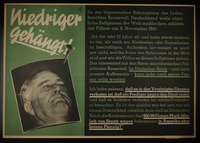
German propaganda poster claiming Hitler and the Nazis are not against religion
Object
German propaganda poster, issued the week of December 3 to December 9, 1941, from the Parole der Woche (Word of the Week) series. The poster shows an unflattering picture of United States President Franklin Roosevelt. The German text claims that Roosevelt is a Jewish puppet that said that the Nazis wish to destroy all religion. To refute this, the poster quotes a speech Adolf Hitler gave on November 8, 1941, at Löwenbräukeller in Munich, Germany, to commemorate the anniversary of the Beer Hall Putsch. In the speech, Hitler claims that he does not care what religion a person is. He goes on to falsely claim that religious leaders in the U.S. are barred from speaking out against the state, and that soldiers cannot attend religious ceremonies. The relationship between the Nazi party and religion was complex. Initially, the Party was not openly hostile to the Protestant and Catholic Churches; however, the Party believed that Christianity and Nazism were ideologically incompatible. The Nazi government signed a Concordat with the Vatican, stating it would recognize the Nazi regime, which would in turn would not interfere in the Catholic Church. However, the Concordat was broken by the Nazis with the passage of anti-religious policies to undermine the church’s influence in 1935. The first Word of the Week Series of posters (also referred to as Wandzeitung, or wall newspapers), were distributed on March 16, 1936. The series used colorful, often derogatory caricatures, and photorealistic images with vibrant language to target political adversaries, Jews, Communists, and Germany’s enemies during the war. The series was discontinued in 1943.
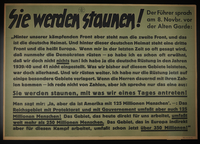
Nazi propaganda poster
Object
The Nazis used propaganda to buttress public support for the war effort, shape public opinion, and reinforce antisemitic ideas. As part of their propaganda campaign, the Nazis created the Word of the Week Series of posters (also referred to as Wandzeitung, or wall newspapers), the first of which was distributed on March 16, 1936. Each week, approximately 125,000 posters were strategically placed in public places and businesses such as: market squares, metro stations, bus stops, payroll offices, hospital waiting rooms, factory cafeterias, schools, hotels, restaurants, post offices, train stations, and street kiosks so that they would be viewed by as many people as possible. Posters were the primary medium for the series, but smaller pamphlets were also produced, which could be plastered on the back of correspondence. The posters used colorful, often derogatory caricatures, and photorealistic images with vibrant language to target the Nazis' early political adversaries, Jews, Communists, and Germany's enemies during the war. The series was discontinued in 1943.

Nazi propaganda poster
Object
The Nazis used propaganda to buttress public support for the war effort, shape public opinion, and reinforce antisemitic ideas. As part of their propaganda campaign, the Nazis created the Word of the Week Series of posters (also referred to as Wandzeitung, or wall newspapers), the first of which was distributed on March 16, 1936. Each week, approximately 125,000 posters were strategically placed in public places and businesses such as: market squares, metro stations, bus stops, payroll offices, hospital waiting rooms, factory cafeterias, schools, hotels, restaurants, post offices, train stations, and street kiosks so that they would be viewed by as many people as possible. Posters were the primary medium for the series, but smaller pamphlets were also produced, which could be plastered on the back of correspondence. The posters used colorful, often derogatory caricatures, and photorealistic images with vibrant language to target the Nazis' early political adversaries, Jews, Communists, and Germany's enemies during the war. The series was discontinued in 1943.

Nazi propaganda poster
Object
The Nazis used propaganda to buttress public support for the war effort, shape public opinion, and reinforce antisemitic ideas. As part of their propaganda campaign, the Nazis created the Word of the Week Series of posters (also referred to as Wandzeitung, or wall newspapers), the first of which was distributed on March 16, 1936. Each week, approximately 125,000 posters were strategically placed in public places and businesses such as: market squares, metro stations, bus stops, payroll offices, hospital waiting rooms, factory cafeterias, schools, hotels, restaurants, post offices, train stations, and street kiosks so that they would be viewed by as many people as possible. Posters were the primary medium for the series, but smaller pamphlets were also produced, which could be plastered on the back of correspondence. The posters used colorful, often derogatory caricatures, and photorealistic images with vibrant language to target the Nazis' early political adversaries, Jews, Communists, and Germany's enemies during the war. The series was discontinued in 1943.
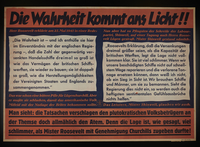
Nazi propaganda poster
Object
The Nazis used propaganda to buttress public support for the war effort, shape public opinion, and reinforce antisemitic ideas. As part of their propaganda campaign, the Nazis created the Word of the Week Series of posters (also referred to as Wandzeitung, or wall newspapers), the first of which was distributed on March 16, 1936. Each week, approximately 125,000 posters were strategically placed in public places and businesses such as: market squares, metro stations, bus stops, payroll offices, hospital waiting rooms, factory cafeterias, schools, hotels, restaurants, post offices, train stations, and street kiosks so that they would be viewed by as many people as possible. Posters were the primary medium for the series, but smaller pamphlets were also produced, which could be plastered on the back of correspondence. The posters used colorful, often derogatory caricatures, and photorealistic images with vibrant language to target the Nazis' early political adversaries, Jews, Communists, and Germany's enemies during the war. The series was discontinued in 1943.
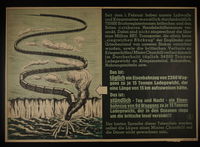
Nazi propaganda poster
Object
The Nazis used propaganda to buttress public support for the war effort, shape public opinion, and reinforce antisemitic ideas. As part of their propaganda campaign, the Nazis created the Word of the Week Series of posters (also referred to as Wandzeitung, or wall newspapers), the first of which was distributed on March 16, 1936. Each week, approximately 125,000 posters were strategically placed in public places and businesses such as: market squares, metro stations, bus stops, payroll offices, hospital waiting rooms, factory cafeterias, schools, hotels, restaurants, post offices, train stations, and street kiosks so that they would be viewed by as many people as possible. Posters were the primary medium for the series, but smaller pamphlets were also produced, which could be plastered on the back of correspondence. The posters used colorful, often derogatory caricatures, and photorealistic images with vibrant language to target the Nazis' early political adversaries, Jews, Communists, and Germany's enemies during the war. The series was discontinued in 1943.
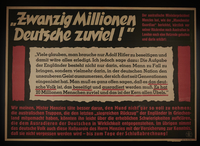
Nazi propaganda poster
Object
The Nazis used propaganda to buttress public support for the war effort, shape public opinion, and reinforce antisemitic ideas. As part of their propaganda campaign, the Nazis created the Word of the Week Series of posters (also referred to as Wandzeitung, or wall newspapers), the first of which was distributed on March 16, 1936. Each week, approximately 125,000 posters were strategically placed in public places and businesses such as: market squares, metro stations, bus stops, payroll offices, hospital waiting rooms, factory cafeterias, schools, hotels, restaurants, post offices, train stations, and street kiosks so that they would be viewed by as many people as possible. Posters were the primary medium for the series, but smaller pamphlets were also produced, which could be plastered on the back of correspondence. The posters used colorful, often derogatory caricatures, and photorealistic images with vibrant language to target the Nazis' early political adversaries, Jews, Communists, and Germany's enemies during the war. The series was discontinued in 1943.
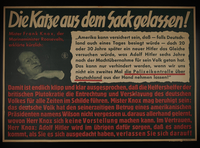
Nazi propaganda poster
Object
The Nazis used propaganda to buttress public support for the war effort, shape public opinion, and reinforce antisemitic ideas. As part of their propaganda campaign, the Nazis created the Word of the Week Series of posters (also referred to as Wandzeitung, or wall newspapers), the first of which was distributed on March 16, 1936. Each week, approximately 125,000 posters were strategically placed in public places and businesses such as: market squares, metro stations, bus stops, payroll offices, hospital waiting rooms, factory cafeterias, schools, hotels, restaurants, post offices, train stations, and street kiosks so that they would be viewed by as many people as possible. Posters were the primary medium for the series, but smaller pamphlets were also produced, which could be plastered on the back of correspondence. The posters used colorful, often derogatory caricatures, and photorealistic images with vibrant language to target the Nazis' early political adversaries, Jews, Communists, and Germany's enemies during the war. The series was discontinued in 1943.
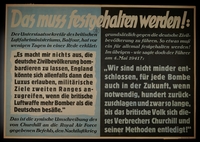
Nazi propaganda poster
Object
The Nazis used propaganda to buttress public support for the war effort, shape public opinion, and reinforce antisemitic ideas. As part of their propaganda campaign, the Nazis created the Word of the Week Series of posters (also referred to as Wandzeitung, or wall newspapers), the first of which was distributed on March 16, 1936. Each week, approximately 125,000 posters were strategically placed in public places and businesses such as: market squares, metro stations, bus stops, payroll offices, hospital waiting rooms, factory cafeterias, schools, hotels, restaurants, post offices, train stations, and street kiosks so that they would be viewed by as many people as possible. Posters were the primary medium for the series, but smaller pamphlets were also produced, which could be plastered on the back of correspondence. The posters used colorful, often derogatory caricatures, and photorealistic images with vibrant language to target the Nazis' early political adversaries, Jews, Communists, and Germany's enemies during the war. The series was discontinued in 1943.
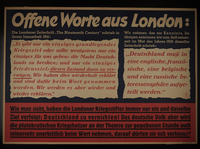
Nazi propaganda poster
Object
The Nazis used propaganda to buttress public support for the war effort, shape public opinion, and reinforce antisemitic ideas. As part of their propaganda campaign, the Nazis created the Word of the Week Series of posters (also referred to as Wandzeitung, or wall newspapers), the first of which was distributed on March 16, 1936. Each week, approximately 125,000 posters were strategically placed in public places and businesses such as: market squares, metro stations, bus stops, payroll offices, hospital waiting rooms, factory cafeterias, schools, hotels, restaurants, post offices, train stations, and street kiosks so that they would be viewed by as many people as possible. Posters were the primary medium for the series, but smaller pamphlets were also produced, which could be plastered on the back of correspondence. The posters used colorful, often derogatory caricatures, and photorealistic images with vibrant language to target the Nazis' early political adversaries, Jews, Communists, and Germany's enemies during the war. The series was discontinued in 1943.
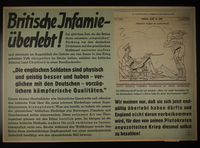
Nazi propaganda poster
Object
The Nazis used propaganda to buttress public support for the war effort, shape public opinion, and reinforce antisemitic ideas. As part of their propaganda campaign, the Nazis created the Word of the Week Series of posters (also referred to as Wandzeitung, or wall newspapers), the first of which was distributed on March 16, 1936. Each week, approximately 125,000 posters were strategically placed in public places and businesses such as: market squares, metro stations, bus stops, payroll offices, hospital waiting rooms, factory cafeterias, schools, hotels, restaurants, post offices, train stations, and street kiosks so that they would be viewed by as many people as possible. Posters were the primary medium for the series, but smaller pamphlets were also produced, which could be plastered on the back of correspondence. The posters used colorful, often derogatory caricatures, and photorealistic images with vibrant language to target the Nazis' early political adversaries, Jews, Communists, and Germany's enemies during the war. The series was discontinued in 1943.
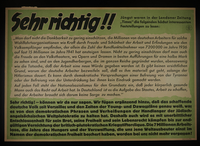
Nazi propaganda poster
Object
The Nazis used propaganda to buttress public support for the war effort, shape public opinion, and reinforce antisemitic ideas. As part of their propaganda campaign, the Nazis created the Word of the Week Series of posters (also referred to as Wandzeitung, or wall newspapers), the first of which was distributed on March 16, 1936. Each week, approximately 125,000 posters were strategically placed in public places and businesses such as: market squares, metro stations, bus stops, payroll offices, hospital waiting rooms, factory cafeterias, schools, hotels, restaurants, post offices, train stations, and street kiosks so that they would be viewed by as many people as possible. Posters were the primary medium for the series, but smaller pamphlets were also produced, which could be plastered on the back of correspondence. The posters used colorful, often derogatory caricatures, and photorealistic images with vibrant language to target the Nazis' early political adversaries, Jews, Communists, and Germany's enemies during the war. The series was discontinued in 1943.
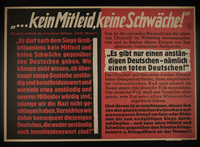
Nazi propaganda poster
Object
The Nazis used propaganda to buttress public support for the war effort, shape public opinion, and reinforce antisemitic ideas. As part of their propaganda campaign, the Nazis created the Word of the Week Series of posters (also referred to as Wandzeitung, or wall newspapers), the first of which was distributed on March 16, 1936. Each week, approximately 125,000 posters were strategically placed in public places and businesses such as: market squares, metro stations, bus stops, payroll offices, hospital waiting rooms, factory cafeterias, schools, hotels, restaurants, post offices, train stations, and street kiosks so that they would be viewed by as many people as possible. Posters were the primary medium for the series, but smaller pamphlets were also produced, which could be plastered on the back of correspondence. The posters used colorful, often derogatory caricatures, and photorealistic images with vibrant language to target the Nazis' early political adversaries, Jews, Communists, and Germany's enemies during the war. The series was discontinued in 1943.
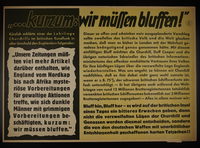
Nazi propaganda poster
Object
The Nazis used propaganda to buttress public support for the war effort, shape public opinion, and reinforce antisemitic ideas. As part of their propaganda campaign, the Nazis created the Word of the Week Series of posters (also referred to as Wandzeitung, or wall newspapers), the first of which was distributed on March 16, 1936. Each week, approximately 125,000 posters were strategically placed in public places and businesses such as: market squares, metro stations, bus stops, payroll offices, hospital waiting rooms, factory cafeterias, schools, hotels, restaurants, post offices, train stations, and street kiosks so that they would be viewed by as many people as possible. Posters were the primary medium for the series, but smaller pamphlets were also produced, which could be plastered on the back of correspondence. The posters used colorful, often derogatory caricatures, and photorealistic images with vibrant language to target the Nazis' early political adversaries, Jews, Communists, and Germany's enemies during the war. The series was discontinued in 1943.
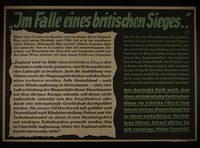
Nazi propaganda poster
Object
The Nazis used propaganda to buttress public support for the war effort, shape public opinion, and reinforce antisemitic ideas. As part of their propaganda campaign, the Nazis created the Word of the Week Series of posters (also referred to as Wandzeitung, or wall newspapers), the first of which was distributed on March 16, 1936. Each week, approximately 125,000 posters were strategically placed in public places and businesses such as: market squares, metro stations, bus stops, payroll offices, hospital waiting rooms, factory cafeterias, schools, hotels, restaurants, post offices, train stations, and street kiosks so that they would be viewed by as many people as possible. Posters were the primary medium for the series, but smaller pamphlets were also produced, which could be plastered on the back of correspondence. The posters used colorful, often derogatory caricatures, and photorealistic images with vibrant language to target the Nazis' early political adversaries, Jews, Communists, and Germany's enemies during the war. The series was discontinued in 1943.
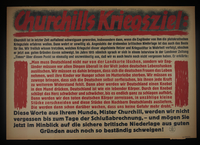
Nazi propaganda poster
Object
The Nazis used propaganda to buttress public support for the war effort, shape public opinion, and reinforce antisemitic ideas. As part of their propaganda campaign, the Nazis created the Word of the Week Series of posters (also referred to as Wandzeitung, or wall newspapers), the first of which was distributed on March 16, 1936. Each week, approximately 125,000 posters were strategically placed in public places and businesses such as: market squares, metro stations, bus stops, payroll offices, hospital waiting rooms, factory cafeterias, schools, hotels, restaurants, post offices, train stations, and street kiosks so that they would be viewed by as many people as possible. Posters were the primary medium for the series, but smaller pamphlets were also produced, which could be plastered on the back of correspondence. The posters used colorful, often derogatory caricatures, and photorealistic images with vibrant language to target the Nazis' early political adversaries, Jews, Communists, and Germany's enemies during the war. The series was discontinued in 1943.
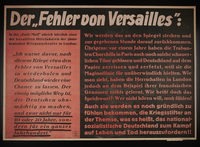
Nazi propaganda poster
Object
The Nazis used propaganda to buttress public support for the war effort, shape public opinion, and reinforce antisemitic ideas. As part of their propaganda campaign, the Nazis created the Word of the Week Series of posters (also referred to as Wandzeitung, or wall newspapers), the first of which was distributed on March 16, 1936. Each week, approximately 125,000 posters were strategically placed in public places and businesses such as: market squares, metro stations, bus stops, payroll offices, hospital waiting rooms, factory cafeterias, schools, hotels, restaurants, post offices, train stations, and street kiosks so that they would be viewed by as many people as possible. Posters were the primary medium for the series, but smaller pamphlets were also produced, which could be plastered on the back of correspondence. The posters used colorful, often derogatory caricatures, and photorealistic images with vibrant language to target the Nazis' early political adversaries, Jews, Communists, and Germany's enemies during the war. The series was discontinued in 1943.
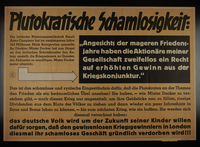
Nazi propaganda poster
Object
The Nazis used propaganda to buttress public support for the war effort, shape public opinion, and reinforce antisemitic ideas. As part of their propaganda campaign, the Nazis created the Word of the Week Series of posters (also referred to as Wandzeitung, or wall newspapers), the first of which was distributed on March 16, 1936. Each week, approximately 125,000 posters were strategically placed in public places and businesses such as: market squares, metro stations, bus stops, payroll offices, hospital waiting rooms, factory cafeterias, schools, hotels, restaurants, post offices, train stations, and street kiosks so that they would be viewed by as many people as possible. Posters were the primary medium for the series, but smaller pamphlets were also produced, which could be plastered on the back of correspondence. The posters used colorful, often derogatory caricatures, and photorealistic images with vibrant language to target the Nazis' early political adversaries, Jews, Communists, and Germany's enemies during the war. The series was discontinued in 1943.

Nazi propaganda poster
Object
The Nazis used propaganda to buttress public support for the war effort, shape public opinion, and reinforce antisemitic ideas. As part of their propaganda campaign, the Nazis created the Word of the Week Series of posters (also referred to as Wandzeitung, or wall newspapers), the first of which was distributed on March 16, 1936. Each week, approximately 125,000 posters were strategically placed in public places and businesses such as: market squares, metro stations, bus stops, payroll offices, hospital waiting rooms, factory cafeterias, schools, hotels, restaurants, post offices, train stations, and street kiosks so that they would be viewed by as many people as possible. Posters were the primary medium for the series, but smaller pamphlets were also produced, which could be plastered on the back of correspondence. The posters used colorful, often derogatory caricatures, and photorealistic images with vibrant language to target the Nazis' early political adversaries, Jews, Communists, and Germany's enemies during the war. The series was discontinued in 1943.
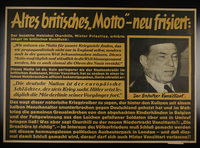
Nazi propaganda poster
Object
The Nazis used propaganda to buttress public support for the war effort, shape public opinion, and reinforce antisemitic ideas. As part of their propaganda campaign, the Nazis created the Word of the Week Series of posters (also referred to as Wandzeitung, or wall newspapers), the first of which was distributed on March 16, 1936. Each week, approximately 125,000 posters were strategically placed in public places and businesses such as: market squares, metro stations, bus stops, payroll offices, hospital waiting rooms, factory cafeterias, schools, hotels, restaurants, post offices, train stations, and street kiosks so that they would be viewed by as many people as possible. Posters were the primary medium for the series, but smaller pamphlets were also produced, which could be plastered on the back of correspondence. The posters used colorful, often derogatory caricatures, and photorealistic images with vibrant language to target the Nazis' early political adversaries, Jews, Communists, and Germany's enemies during the war. The series was discontinued in 1943.
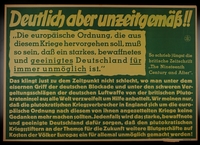
Nazi propaganda poster
Object
The Nazis used propaganda to buttress public support for the war effort, shape public opinion, and reinforce antisemitic ideas. As part of their propaganda campaign, the Nazis created the Word of the Week Series of posters (also referred to as Wandzeitung, or wall newspapers), the first of which was distributed on March 16, 1936. Each week, approximately 125,000 posters were strategically placed in public places and businesses such as: market squares, metro stations, bus stops, payroll offices, hospital waiting rooms, factory cafeterias, schools, hotels, restaurants, post offices, train stations, and street kiosks so that they would be viewed by as many people as possible. Posters were the primary medium for the series, but smaller pamphlets were also produced, which could be plastered on the back of correspondence. The posters used colorful, often derogatory caricatures, and photorealistic images with vibrant language to target the Nazis' early political adversaries, Jews, Communists, and Germany's enemies during the war. The series was discontinued in 1943.
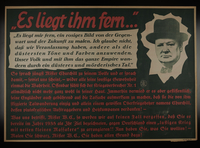
Nazi propaganda poster
Object
The Nazis used propaganda to buttress public support for the war effort, shape public opinion, and reinforce antisemitic ideas. As part of their propaganda campaign, the Nazis created the Word of the Week Series of posters (also referred to as Wandzeitung, or wall newspapers), the first of which was distributed on March 16, 1936. Each week, approximately 125,000 posters were strategically placed in public places and businesses such as: market squares, metro stations, bus stops, payroll offices, hospital waiting rooms, factory cafeterias, schools, hotels, restaurants, post offices, train stations, and street kiosks so that they would be viewed by as many people as possible. Posters were the primary medium for the series, but smaller pamphlets were also produced, which could be plastered on the back of correspondence. The posters used colorful, often derogatory caricatures, and photorealistic images with vibrant language to target the Nazis' early political adversaries, Jews, Communists, and Germany's enemies during the war. The series was discontinued in 1943.
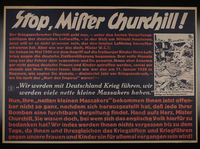
Nazi propaganda poster
Object
The Nazis used propaganda to buttress public support for the war effort, shape public opinion, and reinforce antisemitic ideas. As part of their propaganda campaign, the Nazis created the Word of the Week Series of posters (also referred to as Wandzeitung, or wall newspapers), the first of which was distributed on March 16, 1936. Each week, approximately 125,000 posters were strategically placed in public places and businesses such as: market squares, metro stations, bus stops, payroll offices, hospital waiting rooms, factory cafeterias, schools, hotels, restaurants, post offices, train stations, and street kiosks so that they would be viewed by as many people as possible. Posters were the primary medium for the series, but smaller pamphlets were also produced, which could be plastered on the back of correspondence. The posters used colorful, often derogatory caricatures, and photorealistic images with vibrant language to target the Nazis' early political adversaries, Jews, Communists, and Germany's enemies during the war. The series was discontinued in 1943.
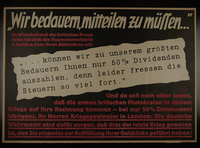
Nazi propaganda poster
Object
The Nazis used propaganda to buttress public support for the war effort, shape public opinion, and reinforce antisemitic ideas. As part of their propaganda campaign, the Nazis created the Word of the Week Series of posters (also referred to as Wandzeitung, or wall newspapers), the first of which was distributed on March 16, 1936. Each week, approximately 125,000 posters were strategically placed in public places and businesses such as: market squares, metro stations, bus stops, payroll offices, hospital waiting rooms, factory cafeterias, schools, hotels, restaurants, post offices, train stations, and street kiosks so that they would be viewed by as many people as possible. Posters were the primary medium for the series, but smaller pamphlets were also produced, which could be plastered on the back of correspondence. The posters used colorful, often derogatory caricatures, and photorealistic images with vibrant language to target the Nazis' early political adversaries, Jews, Communists, and Germany's enemies during the war. The series was discontinued in 1943.
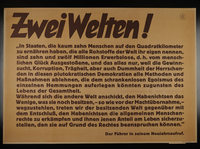
Nazi propaganda poster
Object
The Nazis used propaganda to buttress public support for the war effort, shape public opinion, and reinforce antisemitic ideas. As part of their propaganda campaign, the Nazis created the Word of the Week Series of posters (also referred to as Wandzeitung, or wall newspapers), the first of which was distributed on March 16, 1936. Each week, approximately 125,000 posters were strategically placed in public places and businesses such as: market squares, metro stations, bus stops, payroll offices, hospital waiting rooms, factory cafeterias, schools, hotels, restaurants, post offices, train stations, and street kiosks so that they would be viewed by as many people as possible. Posters were the primary medium for the series, but smaller pamphlets were also produced, which could be plastered on the back of correspondence. The posters used colorful, often derogatory caricatures, and photorealistic images with vibrant language to target the Nazis' early political adversaries, Jews, Communists, and Germany's enemies during the war. The series was discontinued in 1943.
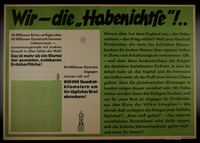
Nazi propaganda poster predicting victory by the deserving German have-nots over the greedy British haves
Object
Nazi propaganda poster, Wir - die Habenichtse!,[We the Have-Nots!] issued on January 13, 1941, for the Parole der Woche (Slogan of the Week] series. The text only poster explains how Britain has stolen by force most of the habitable land on earth. This is because their greedy leaders let the workers live in slums and garbage. But the German people need not worry because they, the have-nots, would win because they are fighting for their bread and will break the spines of these bloodsuckers. Parole der Woche was produced by the Nazi Party in Germany from 1936-1943. It was discontinued in 1943 because of paper shortages caused by the prolonged war.
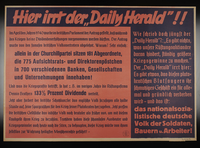
Nazi propaganda poster
Object
The Nazis used propaganda to buttress public support for the war effort, shape public opinion, and reinforce antisemitic ideas. As part of their propaganda campaign, the Nazis created the Word of the Week Series of posters (also referred to as Wandzeitung, or wall newspapers), the first of which was distributed on March 16, 1936. Each week, approximately 125,000 posters were strategically placed in public places and businesses such as: market squares, metro stations, bus stops, payroll offices, hospital waiting rooms, factory cafeterias, schools, hotels, restaurants, post offices, train stations, and street kiosks so that they would be viewed by as many people as possible. Posters were the primary medium for the series, but smaller pamphlets were also produced, which could be plastered on the back of correspondence. The posters used colorful, often derogatory caricatures, and photorealistic images with vibrant language to target the Nazis' early political adversaries, Jews, Communists, and Germany's enemies during the war. The series was discontinued in 1943.
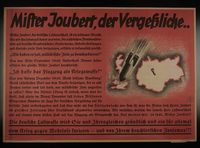
Nazi propaganda poster
Object
The Nazis used propaganda to buttress public support for the war effort, shape public opinion, and reinforce antisemitic ideas. As part of their propaganda campaign, the Nazis created the Word of the Week Series of posters (also referred to as Wandzeitung, or wall newspapers), the first of which was distributed on March 16, 1936. Each week, approximately 125,000 posters were strategically placed in public places and businesses such as: market squares, metro stations, bus stops, payroll offices, hospital waiting rooms, factory cafeterias, schools, hotels, restaurants, post offices, train stations, and street kiosks so that they would be viewed by as many people as possible. Posters were the primary medium for the series, but smaller pamphlets were also produced, which could be plastered on the back of correspondence. The posters used colorful, often derogatory caricatures, and photorealistic images with vibrant language to target the Nazis' early political adversaries, Jews, Communists, and Germany's enemies during the war. The series was discontinued in 1943.
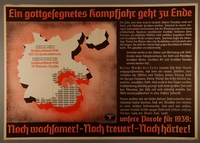
Nazi propaganda poster
Object
The Nazis used propaganda to buttress public support for the war effort, shape public opinion, and reinforce antisemitic ideas. As part of their propaganda campaign, the Nazis created the Word of the Week Series of posters (also referred to as Wandzeitung, or wall newspapers), the first of which was distributed on March 16, 1936. Each week, approximately 125,000 posters were strategically placed in public places and businesses such as: market squares, metro stations, bus stops, payroll offices, hospital waiting rooms, factory cafeterias, schools, hotels, restaurants, post offices, train stations, and street kiosks so that they would be viewed by as many people as possible. Posters were the primary medium for the series, but smaller pamphlets were also produced, which could be plastered on the back of correspondence. The posters used colorful, often derogatory caricatures, and photorealistic images with vibrant language to target the Nazis' early political adversaries, Jews, Communists, and Germany's enemies during the war. The series was discontinued in 1943.
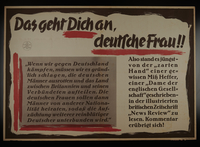
Nazi propaganda text only poster warning German woman of British threats to defile them
Object
Nazi propaganda text only poster, Das geht Dich an, deutsche Frau!! [This is for you, German Women!!] issued on December 4, 1939, for the Parole der Woche (Slogan of the Week) series. The poster reports an allleged British newspaper editorial explaining that the victory of Great Britain over Germany must be absolute. All German males must be killed, the German state and territory divided, and German women forced to marry other nationalities to destroy German racial purity. Parole der Woche was produced by the Nazi Party in Germany from 1936-1943. The series was discontinued in 1943 because of paper shortages caused by the prolonged war.
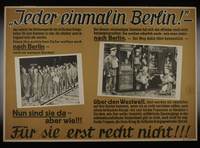
Nazi propaganda poster
Object
The Nazis used propaganda to buttress public support for the war effort, shape public opinion, and reinforce antisemitic ideas. As part of their propaganda campaign, the Nazis created the Word of the Week Series of posters (also referred to as Wandzeitung, or wall newspapers), the first of which was distributed on March 16, 1936. Each week, approximately 125,000 posters were strategically placed in public places and businesses such as: market squares, metro stations, bus stops, payroll offices, hospital waiting rooms, factory cafeterias, schools, hotels, restaurants, post offices, train stations, and street kiosks so that they would be viewed by as many people as possible. Posters were the primary medium for the series, but smaller pamphlets were also produced, which could be plastered on the back of correspondence. The posters used colorful, often derogatory caricatures, and photorealistic images with vibrant language to target the Nazis' early political adversaries, Jews, Communists, and Germany's enemies during the war. The series was discontinued in 1943.
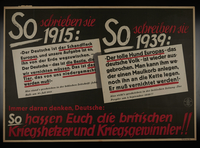
Nazi propaganda poster
Object
The Nazis used propaganda to buttress public support for the war effort, shape public opinion, and reinforce antisemitic ideas. As part of their propaganda campaign, the Nazis created the Word of the Week Series of posters (also referred to as Wandzeitung, or wall newspapers), the first of which was distributed on March 16, 1936. Each week, approximately 125,000 posters were strategically placed in public places and businesses such as: market squares, metro stations, bus stops, payroll offices, hospital waiting rooms, factory cafeterias, schools, hotels, restaurants, post offices, train stations, and street kiosks so that they would be viewed by as many people as possible. Posters were the primary medium for the series, but smaller pamphlets were also produced, which could be plastered on the back of correspondence. The posters used colorful, often derogatory caricatures, and photorealistic images with vibrant language to target the Nazis' early political adversaries, Jews, Communists, and Germany's enemies during the war. The series was discontinued in 1943.
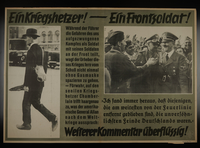
Nazi propaganda poster
Object
The Nazis used propaganda to buttress public support for the war effort, shape public opinion, and reinforce antisemitic ideas. As part of their propaganda campaign, the Nazis created the Word of the Week Series of posters (also referred to as Wandzeitung, or wall newspapers), the first of which was distributed on March 16, 1936. Each week, approximately 125,000 posters were strategically placed in public places and businesses such as: market squares, metro stations, bus stops, payroll offices, hospital waiting rooms, factory cafeterias, schools, hotels, restaurants, post offices, train stations, and street kiosks so that they would be viewed by as many people as possible. Posters were the primary medium for the series, but smaller pamphlets were also produced, which could be plastered on the back of correspondence. The posters used colorful, often derogatory caricatures, and photorealistic images with vibrant language to target the Nazis' early political adversaries, Jews, Communists, and Germany's enemies during the war. The series was discontinued in 1943.
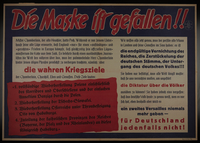
Nazi propaganda poster
Object
The Nazis used propaganda to buttress public support for the war effort, shape public opinion, and reinforce antisemitic ideas. As part of their propaganda campaign, the Nazis created the Word of the Week Series of posters (also referred to as Wandzeitung, or wall newspapers), the first of which was distributed on March 16, 1936. Each week, approximately 125,000 posters were strategically placed in public places and businesses such as: market squares, metro stations, bus stops, payroll offices, hospital waiting rooms, factory cafeterias, schools, hotels, restaurants, post offices, train stations, and street kiosks so that they would be viewed by as many people as possible. Posters were the primary medium for the series, but smaller pamphlets were also produced, which could be plastered on the back of correspondence. The posters used colorful, often derogatory caricatures, and photorealistic images with vibrant language to target the Nazis' early political adversaries, Jews, Communists, and Germany's enemies during the war. The series was discontinued in 1943.
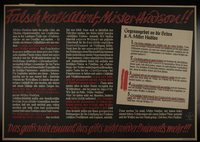
Nazi propaganda poster
Object
The Nazis used propaganda to buttress public support for the war effort, shape public opinion, and reinforce antisemitic ideas. As part of their propaganda campaign, the Nazis created the Word of the Week Series of posters (also referred to as Wandzeitung, or wall newspapers), the first of which was distributed on March 16, 1936. Each week, approximately 125,000 posters were strategically placed in public places and businesses such as: market squares, metro stations, bus stops, payroll offices, hospital waiting rooms, factory cafeterias, schools, hotels, restaurants, post offices, train stations, and street kiosks so that they would be viewed by as many people as possible. Posters were the primary medium for the series, but smaller pamphlets were also produced, which could be plastered on the back of correspondence. The posters used colorful, often derogatory caricatures, and photorealistic images with vibrant language to target the Nazis' early political adversaries, Jews, Communists, and Germany's enemies during the war. The series was discontinued in 1943.
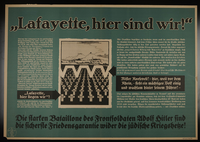
Nazi propaganda poster
Object
The Nazis used propaganda to buttress public support for the war effort, shape public opinion, and reinforce antisemitic ideas. As part of their propaganda campaign, the Nazis created the Word of the Week Series of posters (also referred to as Wandzeitung, or wall newspapers), the first of which was distributed on March 16, 1936. Each week, approximately 125,000 posters were strategically placed in public places and businesses such as: market squares, metro stations, bus stops, payroll offices, hospital waiting rooms, factory cafeterias, schools, hotels, restaurants, post offices, train stations, and street kiosks so that they would be viewed by as many people as possible. Posters were the primary medium for the series, but smaller pamphlets were also produced, which could be plastered on the back of correspondence. The posters used colorful, often derogatory caricatures, and photorealistic images with vibrant language to target the Nazis' early political adversaries, Jews, Communists, and Germany's enemies during the war. The series was discontinued in 1943.
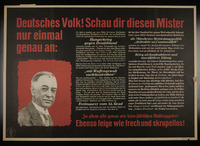
Nazi propaganda poster
Object
The Nazis used propaganda to buttress public support for the war effort, shape public opinion, and reinforce antisemitic ideas. As part of their propaganda campaign, the Nazis created the Word of the Week Series of posters (also referred to as Wandzeitung, or wall newspapers), the first of which was distributed on March 16, 1936. Each week, approximately 125,000 posters were strategically placed in public places and businesses such as: market squares, metro stations, bus stops, payroll offices, hospital waiting rooms, factory cafeterias, schools, hotels, restaurants, post offices, train stations, and street kiosks so that they would be viewed by as many people as possible. Posters were the primary medium for the series, but smaller pamphlets were also produced, which could be plastered on the back of correspondence. The posters used colorful, often derogatory caricatures, and photorealistic images with vibrant language to target the Nazis' early political adversaries, Jews, Communists, and Germany's enemies during the war. The series was discontinued in 1943.
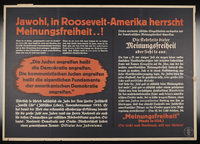
Nazi propaganda poster
Object
The Nazis used propaganda to buttress public support for the war effort, shape public opinion, and reinforce antisemitic ideas. As part of their propaganda campaign, the Nazis created the Word of the Week Series of posters (also referred to as Wandzeitung, or wall newspapers), the first of which was distributed on March 16, 1936. Each week, approximately 125,000 posters were strategically placed in public places and businesses such as: market squares, metro stations, bus stops, payroll offices, hospital waiting rooms, factory cafeterias, schools, hotels, restaurants, post offices, train stations, and street kiosks so that they would be viewed by as many people as possible. Posters were the primary medium for the series, but smaller pamphlets were also produced, which could be plastered on the back of correspondence. The posters used colorful, often derogatory caricatures, and photorealistic images with vibrant language to target the Nazis' early political adversaries, Jews, Communists, and Germany's enemies during the war. The series was discontinued in 1943.
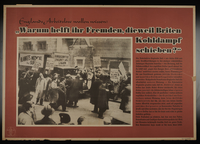
Nazi propaganda poster
Object
The Nazis used propaganda to buttress public support for the war effort, shape public opinion, and reinforce antisemitic ideas. As part of their propaganda campaign, the Nazis created the Word of the Week Series of posters (also referred to as Wandzeitung, or wall newspapers), the first of which was distributed on March 16, 1936. Each week, approximately 125,000 posters were strategically placed in public places and businesses such as: market squares, metro stations, bus stops, payroll offices, hospital waiting rooms, factory cafeterias, schools, hotels, restaurants, post offices, train stations, and street kiosks so that they would be viewed by as many people as possible. Posters were the primary medium for the series, but smaller pamphlets were also produced, which could be plastered on the back of correspondence. The posters used colorful, often derogatory caricatures, and photorealistic images with vibrant language to target the Nazis' early political adversaries, Jews, Communists, and Germany's enemies during the war. The series was discontinued in 1943.
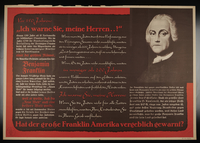
Nazi propaganda poster
Object
The Nazis used propaganda to buttress public support for the war effort, shape public opinion, and reinforce antisemitic ideas. As part of their propaganda campaign, the Nazis created the Word of the Week Series of posters (also referred to as Wandzeitung, or wall newspapers), the first of which was distributed on March 16, 1936. Each week, approximately 125,000 posters were strategically placed in public places and businesses such as: market squares, metro stations, bus stops, payroll offices, hospital waiting rooms, factory cafeterias, schools, hotels, restaurants, post offices, train stations, and street kiosks so that they would be viewed by as many people as possible. Posters were the primary medium for the series, but smaller pamphlets were also produced, which could be plastered on the back of correspondence. The posters used colorful, often derogatory caricatures, and photorealistic images with vibrant language to target the Nazis' early political adversaries, Jews, Communists, and Germany's enemies during the war. The series was discontinued in 1943.
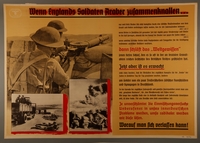
Nazi propaganda poster
Object
The Nazis used propaganda to buttress public support for the war effort, shape public opinion, and reinforce antisemitic ideas. As part of their propaganda campaign, the Nazis created the Word of the Week Series of posters (also referred to as Wandzeitung, or wall newspapers), the first of which was distributed on March 16, 1936. Each week, approximately 125,000 posters were strategically placed in public places and businesses such as: market squares, metro stations, bus stops, payroll offices, hospital waiting rooms, factory cafeterias, schools, hotels, restaurants, post offices, train stations, and street kiosks so that they would be viewed by as many people as possible. Posters were the primary medium for the series, but smaller pamphlets were also produced, which could be plastered on the back of correspondence. The posters used colorful, often derogatory caricatures, and photorealistic images with vibrant language to target the Nazis' early political adversaries, Jews, Communists, and Germany's enemies during the war. The series was discontinued in 1943.

Nazi propaganda poster
Object
The Nazis used propaganda to buttress public support for the war effort, shape public opinion, and reinforce antisemitic ideas. As part of their propaganda campaign, the Nazis created the Word of the Week Series of posters (also referred to as Wandzeitung, or wall newspapers), the first of which was distributed on March 16, 1936. Each week, approximately 125,000 posters were strategically placed in public places and businesses such as: market squares, metro stations, bus stops, payroll offices, hospital waiting rooms, factory cafeterias, schools, hotels, restaurants, post offices, train stations, and street kiosks so that they would be viewed by as many people as possible. Posters were the primary medium for the series, but smaller pamphlets were also produced, which could be plastered on the back of correspondence. The posters used colorful, often derogatory caricatures, and photorealistic images with vibrant language to target the Nazis' early political adversaries, Jews, Communists, and Germany's enemies during the war. The series was discontinued in 1943.
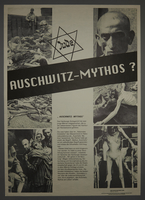
Late 20th-Century poster criticizing a court acquittal of Holocaust deniers
Object
Post-period poster published in 1995, juxtaposing photos of emaciated concentration camp victims with a short editorial about the acquittal of two Holocaust deniers in Hamburg, Germany. In February 1995, a German Judge acquitted two men, both members of the right-wing Freiheitliche Arbeiter Partei (FAP, Free Worker’s Party), of charges stemming from their recording of a message that criticized the film, “Schindler’s List,” as “perpetuating the Auschwitz myth” on an established Neo-Nazi phone line. The judge based his decision on the defense’s successful arguments over the ambiguity of the word “myth.” This ruling followed soon after another high-profile German court decision involving a Holocaust denier involved in a separate incident. The two rulings brought to the forefront long-standing public distrust of the courts’ dealing with Holocaust denial and antisemitism cases. This distrust stemmed from the return of Nazi judges to their posts in the German civil service during the postwar years, and accusations that judges were lenient on right-wing extremists while being harsh in cases against the left. These cases came at a time of intense moral concern over Holocaust denial. The decisions created public scandals, which precipitated intense debates over the judges’ personal and professional backgrounds, as well as the rulings and opinions in the cases.
Nazi propaganda poster
Object
The Nazis used propaganda to buttress public support for the war effort, shape public opinion, and reinforce antisemitic ideas. As part of their propaganda campaign, the Nazis created the Word of the Week Series of posters (also referred to as Wandzeitung, or wall newspapers), the first of which was distributed on March 16, 1936. Each week, approximately 125,000 posters were strategically placed in public places and businesses such as: market squares, metro stations, bus stops, payroll offices, hospital waiting rooms, factory cafeterias, schools, hotels, restaurants, post offices, train stations, and street kiosks so that they would be viewed by as many people as possible. Posters were the primary medium for the series, but smaller pamphlets were also produced, which could be plastered on the back of correspondence. The posters used colorful, often derogatory caricatures, and photorealistic images with vibrant language to target the Nazis' early political adversaries, Jews, Communists, and Germany's enemies during the war. The series was discontinued in 1943.
Nazi propaganda poster
Object
The Nazis used propaganda to buttress public support for the war effort, shape public opinion, and reinforce antisemitic ideas. As part of their propaganda campaign, the Nazis created the Word of the Week Series of posters (also referred to as Wandzeitung, or wall newspapers), the first of which was distributed on March 16, 1936. Each week, approximately 125,000 posters were strategically placed in public places and businesses such as: market squares, metro stations, bus stops, payroll offices, hospital waiting rooms, factory cafeterias, schools, hotels, restaurants, post offices, train stations, and street kiosks so that they would be viewed by as many people as possible. Posters were the primary medium for the series, but smaller pamphlets were also produced, which could be plastered on the back of correspondence. The posters used colorful, often derogatory caricatures, and photorealistic images with vibrant language to target the Nazis' early political adversaries, Jews, Communists, and Germany's enemies during the war. The series was discontinued in 1943.
Nazi propaganda poster
Object
The Nazis used propaganda to buttress public support for the war effort, shape public opinion, and reinforce antisemitic ideas. As part of their propaganda campaign, the Nazis created the Word of the Week Series of posters (also referred to as Wandzeitung, or wall newspapers), the first of which was distributed on March 16, 1936. Each week, approximately 125,000 posters were strategically placed in public places and businesses such as: market squares, metro stations, bus stops, payroll offices, hospital waiting rooms, factory cafeterias, schools, hotels, restaurants, post offices, train stations, and street kiosks so that they would be viewed by as many people as possible. Posters were the primary medium for the series, but smaller pamphlets were also produced, which could be plastered on the back of correspondence. The posters used colorful, often derogatory caricatures, and photorealistic images with vibrant language to target the Nazis' early political adversaries, Jews, Communists, and Germany's enemies during the war. The series was discontinued in 1943.
Nazi propaganda poster
Object
The Nazis used propaganda to buttress public support for the war effort, shape public opinion, and reinforce antisemitic ideas. As part of their propaganda campaign, the Nazis created the Word of the Week Series of posters (also referred to as Wandzeitung, or wall newspapers), the first of which was distributed on March 16, 1936. Each week, approximately 125,000 posters were strategically placed in public places and businesses such as: market squares, metro stations, bus stops, payroll offices, hospital waiting rooms, factory cafeterias, schools, hotels, restaurants, post offices, train stations, and street kiosks so that they would be viewed by as many people as possible. Posters were the primary medium for the series, but smaller pamphlets were also produced, which could be plastered on the back of correspondence. The posters used colorful, often derogatory caricatures, and photorealistic images with vibrant language to target the Nazis' early political adversaries, Jews, Communists, and Germany's enemies during the war. The series was discontinued in 1943.
Nazi propaganda poster
Object
The Nazis used propaganda to buttress public support for the war effort, shape public opinion, and reinforce antisemitic ideas. As part of their propaganda campaign, the Nazis created the Word of the Week Series of posters (also referred to as Wandzeitung, or wall newspapers), the first of which was distributed on March 16, 1936. Each week, approximately 125,000 posters were strategically placed in public places and businesses such as: market squares, metro stations, bus stops, payroll offices, hospital waiting rooms, factory cafeterias, schools, hotels, restaurants, post offices, train stations, and street kiosks so that they would be viewed by as many people as possible. Posters were the primary medium for the series, but smaller pamphlets were also produced, which could be plastered on the back of correspondence. The posters used colorful, often derogatory caricatures, and photorealistic images with vibrant language to target the Nazis' early political adversaries, Jews, Communists, and Germany's enemies during the war. The series was discontinued in 1943.
Nazi propaganda poster
Object
The Nazis used propaganda to buttress public support for the war effort, shape public opinion, and reinforce antisemitic ideas. As part of their propaganda campaign, the Nazis created the Word of the Week Series of posters (also referred to as Wandzeitung, or wall newspapers), the first of which was distributed on March 16, 1936. Each week, approximately 125,000 posters were strategically placed in public places and businesses such as: market squares, metro stations, bus stops, payroll offices, hospital waiting rooms, factory cafeterias, schools, hotels, restaurants, post offices, train stations, and street kiosks so that they would be viewed by as many people as possible. Posters were the primary medium for the series, but smaller pamphlets were also produced, which could be plastered on the back of correspondence. The posters used colorful, often derogatory caricatures, and photorealistic images with vibrant language to target the Nazis' early political adversaries, Jews, Communists, and Germany's enemies during the war. The series was discontinued in 1943.
Nazi propaganda poster
Object
The Nazis used propaganda to buttress public support for the war effort, shape public opinion, and reinforce antisemitic ideas. As part of their propaganda campaign, the Nazis created the Word of the Week Series of posters (also referred to as Wandzeitung, or wall newspapers), the first of which was distributed on March 16, 1936. Each week, approximately 125,000 posters were strategically placed in public places and businesses such as: market squares, metro stations, bus stops, payroll offices, hospital waiting rooms, factory cafeterias, schools, hotels, restaurants, post offices, train stations, and street kiosks so that they would be viewed by as many people as possible. Posters were the primary medium for the series, but smaller pamphlets were also produced, which could be plastered on the back of correspondence. The posters used colorful, often derogatory caricatures, and photorealistic images with vibrant language to target the Nazis' early political adversaries, Jews, Communists, and Germany's enemies during the war. The series was discontinued in 1943.
Nazi propaganda poster
Object
The Nazis used propaganda to buttress public support for the war effort, shape public opinion, and reinforce antisemitic ideas. As part of their propaganda campaign, the Nazis created the Word of the Week Series of posters (also referred to as Wandzeitung, or wall newspapers), the first of which was distributed on March 16, 1936. Each week, approximately 125,000 posters were strategically placed in public places and businesses such as: market squares, metro stations, bus stops, payroll offices, hospital waiting rooms, factory cafeterias, schools, hotels, restaurants, post offices, train stations, and street kiosks so that they would be viewed by as many people as possible. Posters were the primary medium for the series, but smaller pamphlets were also produced, which could be plastered on the back of correspondence. The posters used colorful, often derogatory caricatures, and photorealistic images with vibrant language to target the Nazis' early political adversaries, Jews, Communists, and Germany's enemies during the war. The series was discontinued in 1943.
Nazi propaganda poster
Object
The Nazis used propaganda to buttress public support for the war effort, shape public opinion, and reinforce antisemitic ideas. As part of their propaganda campaign, the Nazis created the Word of the Week Series of posters (also referred to as Wandzeitung, or wall newspapers), the first of which was distributed on March 16, 1936. Each week, approximately 125,000 posters were strategically placed in public places and businesses such as: market squares, metro stations, bus stops, payroll offices, hospital waiting rooms, factory cafeterias, schools, hotels, restaurants, post offices, train stations, and street kiosks so that they would be viewed by as many people as possible. Posters were the primary medium for the series, but smaller pamphlets were also produced, which could be plastered on the back of correspondence. The posters used colorful, often derogatory caricatures, and photorealistic images with vibrant language to target the Nazis' early political adversaries, Jews, Communists, and Germany's enemies during the war. The series was discontinued in 1943.
Nazi propaganda poster
Object
The Nazis used propaganda to buttress public support for the war effort, shape public opinion, and reinforce antisemitic ideas. As part of their propaganda campaign, the Nazis created the Word of the Week Series of posters (also referred to as Wandzeitung, or wall newspapers), the first of which was distributed on March 16, 1936. Each week, approximately 125,000 posters were strategically placed in public places and businesses such as: market squares, metro stations, bus stops, payroll offices, hospital waiting rooms, factory cafeterias, schools, hotels, restaurants, post offices, train stations, and street kiosks so that they would be viewed by as many people as possible. Posters were the primary medium for the series, but smaller pamphlets were also produced, which could be plastered on the back of correspondence. The posters used colorful, often derogatory caricatures, and photorealistic images with vibrant language to target the Nazis' early political adversaries, Jews, Communists, and Germany's enemies during the war. The series was discontinued in 1943.
Nazi propaganda poster
Object
The Nazis used propaganda to buttress public support for the war effort, shape public opinion, and reinforce antisemitic ideas. As part of their propaganda campaign, the Nazis created the Word of the Week Series of posters (also referred to as Wandzeitung, or wall newspapers), the first of which was distributed on March 16, 1936. Each week, approximately 125,000 posters were strategically placed in public places and businesses such as: market squares, metro stations, bus stops, payroll offices, hospital waiting rooms, factory cafeterias, schools, hotels, restaurants, post offices, train stations, and street kiosks so that they would be viewed by as many people as possible. Posters were the primary medium for the series, but smaller pamphlets were also produced, which could be plastered on the back of correspondence. The posters used colorful, often derogatory caricatures, and photorealistic images with vibrant language to target the Nazis' early political adversaries, Jews, Communists, and Germany's enemies during the war. The series was discontinued in 1943.
Nazi propaganda poster
Object
The Nazis used propaganda to buttress public support for the war effort, shape public opinion, and reinforce antisemitic ideas. As part of their propaganda campaign, the Nazis created the Word of the Week Series of posters (also referred to as Wandzeitung, or wall newspapers), the first of which was distributed on March 16, 1936. Each week, approximately 125,000 posters were strategically placed in public places and businesses such as: market squares, metro stations, bus stops, payroll offices, hospital waiting rooms, factory cafeterias, schools, hotels, restaurants, post offices, train stations, and street kiosks so that they would be viewed by as many people as possible. Posters were the primary medium for the series, but smaller pamphlets were also produced, which could be plastered on the back of correspondence. The posters used colorful, often derogatory caricatures, and photorealistic images with vibrant language to target the Nazis' early political adversaries, Jews, Communists, and Germany's enemies during the war. The series was discontinued in 1943.
Nazi propaganda poster
Object
The Nazis used propaganda to buttress public support for the war effort, shape public opinion, and reinforce antisemitic ideas. As part of their propaganda campaign, the Nazis created the Word of the Week Series of posters (also referred to as Wandzeitung, or wall newspapers), the first of which was distributed on March 16, 1936. Each week, approximately 125,000 posters were strategically placed in public places and businesses such as: market squares, metro stations, bus stops, payroll offices, hospital waiting rooms, factory cafeterias, schools, hotels, restaurants, post offices, train stations, and street kiosks so that they would be viewed by as many people as possible. Posters were the primary medium for the series, but smaller pamphlets were also produced, which could be plastered on the back of correspondence. The posters used colorful, often derogatory caricatures, and photorealistic images with vibrant language to target the Nazis' early political adversaries, Jews, Communists, and Germany's enemies during the war. The series was discontinued in 1943.



